Friday, July 31, 2020
Memory loss reversed or abated in those with cognitive decline
from Healthy Aging News -- ScienceDaily https://ift.tt/33g1A9g
Forty percent of dementia cases could be prevented or delayed by targeting 12 risk factors throughout life
from Healthy Aging News -- ScienceDaily https://ift.tt/2D5ZwWI
Why Americans Think it’s a Good Idea to Remember to Smile – And New Yorkers Get a Huge Reminder
Survey of Americans found that half believe it’s important during lockdown to smile–and New Yorkers were reminded with huge smiley face on Brooklyn Bridge.
The post Why Americans Think it’s a Good Idea to Remember to Smile – And New Yorkers Get a Huge Reminder appeared first on Good News Network.
from Good News Network https://ift.tt/3fjfARS
How to Love Someone in the Way They Need
What Is Love?
The word love is both a noun and a verb. In relationships, be that as it may, it is mostly demonstrated with some type of action, subtle or grand, but an action, nonetheless, making it very much a verb. Love and its multiple meanings leave its expression ample room for creativity. Because it can be expressed in so many ways, it can often leave lovers disappointed in its wake if not received in the anticipated way. Based on disparate backgrounds and world views, people feel love and show love in a myriad of contrasting ways. If you and your partner speak love in the same manner, no problem. You will both be quite happy, satisfied, and in tune with each other. But if you don't, then a little talk might be in order. If you want to have your intimate emotional needs((Medium: Top 5 Emotional Needs in Intimate Relationships)) met, letting your partner know the ways in which you feel loved is important. It's also salient to understand the way in which they express their love. One way is not better than the other. It just has to do with personal preference and feelings of familiarity. Talking about your expectations eliminates the guess work of how to communicate your love to each other. It allows you both to tune into the same channel; you'll get along and feel as though you're getting your love needs met. People are different, and so respond differently to displays of affection, however they may manifest. An important question to ask yourself is, "How do I feel most loved?" And, "How does my partner?" Both have to be addressed and implemented in your relationship if you want it to thrive.How to Show Love
According to Dr. Gary Chapman((Gary Chapman: The 5 Love Languages)), author of The Five Love Languages, he states that there are five basic ways to communicate your love to your partner. Let me break those down for you. This will give you a glimpse into the many ways you can show your partner you love them, in the way they need that to be shown, and vice versa.1. Words of Affirmation
This love speak has to do with the spoken or written word. If you're with someone whose primary language is affirming words of love, you might want to say (often), "I love you! You're the best thing since sliced bread!" Or leave random notes throughout the house proclaiming your undying love. Loving, sweet texts will work, too. If you're with a partner who needs words of affirmation to feel loved, then make sure to tell them in words, and/or in writing, how you feel. You will have one happy camper on your hands. Working eight hours a day to provide for her/him, or bringing home a bouquet of flowers won't necessarily do the trick. Unless, of course, when you hand over the dozen tulips you look into his/her eyes and say, "I love you more than life! You are my soul mate, my one and all. These flowers pale in comparison to your divine beauty!" Now you're talking. More than the actual saying of the words, it's the meaning behind the words that matter most. If your partner speaks this language, they need to know you appreciate them with open and honest communication. Make sure you praise, encourage, tell, write—whatever you can—to express your love. That will have a beautiful impact on your relationship. Remember, however, that negative words((Psychology Today: Why This Word Is So Dangerous to Say or Hear)) can have a very strong impact in the other direction, so be very mindful of what you say and how you say it.2. Acts of Service
The sweetest words I can hear are, "I'll take care of that for you!" Those words make me feel more loved than any other, especially when it relieves me of having to do a stressful task. This is definitely my primary love language. I have major issues with laziness, or someone who doesn't follow through with their commitments. If your partner is like me, then you're going to want to discover where their needs lie. Try to pay attention to the small things in your relationship, and remember them! Bring these up at the correct time to surprise them and make them feel special. They'll appreciate that you took the time to notice what kind of restaurant they like or what movie they like to watch on the weekends((Very Well Mind: How to Use Acts of Service in Your Relationship)). If that's not enough, look around...does something around the house need fixing? Can you help out by making the bed or doing the dishes? Maybe filling up a flat tire on their bike? If your partner's primary love language is acts of service—anything that can take the load off—then find a way to do just that. Your honey will be extremely grateful, trust me.3. Receiving Gifts
Every time my son would FaceTime with his girlfriend, he noticed her struggle to unravel her tangled earbuds. It would always take her several minutes to get situated. So, when he showed up at her house with a pair of wireless earbuds, she was blown away. For a person whose primary love language is receiving gifts, it's more than just the gift itself. My son's girlfriend was wowed because she recognized the thought behind the gift. He was paying attention to her needs. By giving her that gift, he was speaking her language of love. She knew that it came from the heart and his desire to not see her struggle. Without really realizing its importance, my son did a great thing for her. She felt happy, secure, and like someone was really looking out for her. More than the visual sight of the gift, her overwhelming warm and fuzzy feelings came from his motivation. If your partner feels loved by receiving gifts, know that the gifts do not have to be expensive. Even though this is not my primary language, I appreciate useful items. For example, a friend of mine once gave me three sticks of lip balm. Wow! It's such a small thing when you think about it, but I use those all the time, so it was the perfect gift. Little trinkets here and there serve their purpose. It lets the person know you're thinking about them((Very Well Mind: What the Receiving Gifts Love Language Means for a Relationship)) Don't underestimate their power. As long as the gift is from the heart, it's all good.4. Quality Time
One-on-one time, undivided attention, and shared activities...if this sounds good to you, then this is your primary love speak. Quality time probably needs a little more attention than the other four ways to show love because it requires, well, time. And it seems like people nowadays are hard-pressed to provide it because they just don't have it, or they claim not to. So, if your partner feels loved by having cozy dinners, just the two of you, cuddling up and watching movies, going for bike rides, or taking long walks, then make the time. This will make your relationship prosper. Your investment of time will pay amazing dividends. Your partner will feel loved and cared for. Even if this is not the favored love language for either of you, it's critical to spend the time with your mate. This will aid in creating a strong and solid relationship. And as you can see above, it doesn't have to be 24/7. If you fancy being out with friends, rock climbing, running marathons, or what-have-you, don't despair. You can do both. You can have your alone time, just as long as you dedicate that much-appreciated couple's time to your partner.5. Physical Touch
When Dr. Chapman talks about physical touch as being a love language, he's not necessarily referring to touching with sexual undertones. The physical touch to which he is referring is hand holding, a shoulder squeeze, a hand on the back, little touches here and there. My husband's primary love language is physical touch. Mine is not. But because I know that he feels loved by my physical touch, I'll rub his back when I walk by him, or squeeze his hand as we're driving, hug him as we pass each other in the kitchen, etc. Even the smallest acts of touch can go a long way. Even though physical touch is not my preferred love speak, I want my husband to feel loved in the way that he needs, hence I make the effort to make those gestures. His whole demeanor changes. I can feel his happiness through my touch.Incorporating More Than One Love Language
I want to add here that while a person has a desired love language, they can speak a little bit of the other love languages as well. For instance, your love language might be physical touch, but you still really enjoy receiving gifts, or spending quality time with your partner. It's important to know what language your partner speaks, yes. In this way you can show them you love them in the way that it will be the most meaningful to them. You are not sacrificing anything in the process. You will, however, make a big impact on your partner, create feelings of love, security, and happiness. In contrast... While it's wonderful and essential to show your partner love in the way they need, it is just as important to recognize the way in which your partner feels comfortable expressing their love to you. For instance, if their way of expressing love is by doing acts of service for you, don't make them feel diminished, as though they don't love you simply because they didn't come home with a sparkling tennis bracelet. See the value in what they're doing. If that's the way of expressing their love for you, take it. Understand they don't love you any less; they're just showing it in a different way. Negating their methods will just make them feel bad, create an argument, or just make you look ungrateful. David Braucher, LCSW, Ph.D, writes:"Maybe it would be hard for them, though I’m not saying they shouldn’t try. But if we are complaining about what we are not getting without appreciating what we do receive, we are rejecting a very intimate part of them. And we don’t want to reject them! We love them. We love that they love us. We just want them to express their love differently—the way we want it."((Psychology Today: Why Doesn’t My Partner Love Me the Way I Want?))All the love languages are important. You can play around with one or all. One is not better than the other, as I've said. It's important to recognize the way in which we want to be loved and express it, but it goes both ways. Just because your partner forgets your anniversary doesn't mean s/he doesn't love you. It could mean s/he was busy and had a lot on his/her mind.
Final Thoughts
There are many ways to express love. Understanding what your partner needs is essential, but understanding how your partner demonstrates his/her love is just as important. Don't allow your insecurities to manipulate you. If you catch yourself saying, "If s/he loved me, s/he would have..." Not necessarily. Just because someone doesn't express love in the same love language doesn't mean they don't love you. Be grateful for what they do for you and how they express it. Love is the universal language. It can be spoken in many different ways. Allow room in your relationship to speak as many as you can. After all, love is love!More on How to Love Someone
- 26 Romantic Ways to Show Your Love for Someone
- How to Love: 14 Ways to Be a More Loving Partner
- Why You and Your Partner Don’t Need to Speak the Same Love Language to Stay Together
from Lifehack - Feed https://ift.tt/3jXV3pI
Thursday, July 30, 2020
America Civil Rights Leader John Lewis Pens a ‘Letter to The Nation’ in Final Inspiring Farewell
Congressman John Lewis wrote a letter to the nation, offering his final words, in the wake of his unsuccessful battle with stage 4 pancreatic cancer.
The post America Civil Rights Leader John Lewis Pens a ‘Letter to The Nation’ in Final Inspiring Farewell appeared first on Good News Network.
from Good News Network https://ift.tt/2PcuwXC
Woman Reunited With Lost Teddy Bear Containing Late Mother’s Voice: ‘Mama Bear‘s Home’
A 28-year-old Canadian woman is reunited with her lost teddy bear that contained a sweet message from her late mother recorded inside.
The post Woman Reunited With Lost Teddy Bear Containing Late Mother’s Voice: ‘Mama Bear‘s Home’ appeared first on Good News Network.
from Good News Network https://ift.tt/33aIh1d
'Drawn-on-skin' electronics offer breakthrough in wearable monitors
from Skin Care News -- ScienceDaily https://ift.tt/2P6pZWu
Alzheimer's risk factors may be measurable in adolescents and young adults
from Healthy Aging News -- ScienceDaily https://ift.tt/39Fer64
Wednesday, July 29, 2020
New blood test shows great promise in the diagnosis of Alzheimer's disease
from Healthy Aging News -- ScienceDaily https://ift.tt/2P4ruV0
7 Tips for Overcoming Challenges in Life like a Pro
1. Shift Your Perspective
Every challenging situation, right off the bat, affects your perspective first. Let’s say, this morning, you woke up to an email from your boss that said that you have to work through the weekend too. You had planned to meet your friends after months this weekend. Of course, you’ll instantly start to feel extremely mad and sad. Next, you open the fridge to make some eggs in breakfast, but the eggs have gone bad. You’re also out of cereal. Later on in the day, you have to go out for grocery shopping, but your favorite, most comfortable jeans are dirty. Although this inconvenience is minor, it could possibly be the last straw that will make you want to start screaming at this point. Apparently, your entire day has gone in the wrong direction. But the real issue is that not that minor challenges got to you back to back. Instead, it’s your perspective. From the moment you read the email, you put on a negative paradigm. Since then, everything was perceived as a bigger problem than it actually is. You already knew that you were out of cereal. You also probably knew that the eggs would go bad by this day. Despite that, your negative mindset made your overreact. So, make it a habit to never let negativity take over. Yes, you shouldn’t be positive forcefully. However, focus only your negative energy on the real challenge. Ignore the minor inconveniences like you would on a good day. If you let your energy go to waste on such small matters, you’ll be drained of energy before you even begin to fight against the real challenge.2. Learn From Someone Who Has Been Through It
If it gives you comfort, then you should know that you’re not the only one going through this issue. Someone out there is going through exactly similar circumstances and possibly even worse. Similarly, there’s someone out there who has been through the same challenge but was able to get out of it unharmed. There are millions of people in similar circumstances. You may know at least one such individual who has gone through a similar issue. It could be a celebrity, someone from your neighborhood, a member from your extended family, or anyone from anywhere. This person’s experience is a source of motivation as well as a guide to get through your challenge. Overcoming challenges can be as easy as observing the people around you. If you can’t think of anyone who has tackled the problem already, it’s alright. You’ll know of someone who, if ever faced with a similar situation, could walk through it without an issue. Maybe that’s because this person has enough money to buy their solution, or they have the physical and mental ability to find a way out. Whatever the case, try to follow the same footsteps. Come up with alternatives to suit your circumstances. As long as you have an example to see, you’ll have the strong will to continue in the same direction. A real-life example is the best motivation to continue the fight against your life’s hurdles.3. Don’t Shy Away From Help for Overcoming Challenges
You came into this world alone and you’ll leave alone. Yet, every human depends on the other for their survival between these two points of existence. Even the strongest economies in the world are interdependent. So, it’s only okay to expect an emotionally or physically strained person like you to seek help as well. The reason why you should ask for help is not that you aren’t capable of pulling yourself out of the tough situation. But since you’re the one suffering through it, you’re already drained. Moreover, your perspective is way different than that of a third person. Having someone to support you through your tough time is great. The best scenario is if they have the expertise to get you over the hurdle. Even if that’s not the case, the emotional support is more than enough to keep you going in tough times.4. Figure Out a Solution
Nothing (yes, nothing) in life is unsolvable (except for some mathematics problems). But as far as the everyday life issues are concerned, there’s always a solution. No matter how big of a mountain you think has come in front of you, it won’t kill you. You can reach its top only if you’re determined to. If you’re thinking of ways of overcoming challenges, you’re already on the right track. Only with a mind that wants to overcome an issue can you actually do it. So, start thinking of all possible and impossible solutions to your problem. For example, if you’re currently going through a financial problem, some solutions include shifting to a better-paid job, working more than one job, taking a loan, winning a lottery, robbing a bank, and the list goes on. Simply knowing that there are so many solutions to your problem, half your worries will eradicate. The next step is, of course, to work on this solution. Once you’re figured out the most feasible route for yourself, you need to start taking baby steps towards it. Let’s say you decided to shift your job. So, you’ll start by looking out for career choices that pay well and are also relevant to your skills and experience. Next, you’ll apply to places that have open vacancies, and so on. With a focused goal, you’ll not lose your sense of direction amid all the hindrances.5. Compartmentalize
Do you know what pulls people down during a tough time? It’s not that one challenge but the fact that this one challenge takes over all other parts of their life too. An issue in your career reflects on your behavior with your partner, keeps you from hanging out with your friends, strains your motivation to stay fit, and basically harms every other aspect. All of this is because that one challenge is all that’s on your mind. You just cannot distract your brain to think of other things. This behavior is harmful not just for yourself but also for those around you. Keep the challenges of your life restricted. If they take over, you won’t be able to overcome them. To solve one problem, you need to continue to live normally in other parts so that you don’t lose your strength. Learn to compartmentalize so that your brain is trained to keep the good things away from the negative.((Guideposts: 3 Healthy Ways to Compartmentalize Emotions)) With an organized mind, you can conquer any challenge that comes to you.6. Focus on the Bigger Picture
One closed door opens another. That’s an extremely true saying. One hurdle may seem like a full stop, but it may be exactly what you need to reach a final goal. Imagine the prettiest landscape; a land full of peace, serenity, natural beauty, starry sky, and everything nice that you can think of. If you know that the final destination is worth it, you won’t mind the narrow path that you’ll have to walk on to get to it. Similarly, if you can shift your focus to the bigger picture, the minor challenges won’t seem to be an issue. Instead, you’ll make the most of them by learning from every challenging second. Going through a hard time can bring you many benefits if you have the right point of view.((UW Health: The Surprising Benefit of Going Through Difficult Times))7. Help Others
In the end, despite your challenges, be ready to offer help to others. You will be contributing to the cycle of help while also learning a great deal from their way of tackling a life issue. Moreover, offering a helping hand ensures you’ve got someone you can rely on during your tough times too.The Takeaway
Overcoming challenges in life is not hard. Instead, it is a balanced way to tackle the problem without letting it affect healthy parts of your life. It not only requires physical efforts but also mental strength. The 7 tips you learned today are a good balance between both. They keep you mentally strong so that you can put it your maximum physically. Altogether, you can put up a strong fight against the hardest challenges. No obstacle can stop you from living your life to the fullest. All you’ve got to do now is to stay determined and push yourself by implementing these tips in your life. Then, notice yourself looking forward to new challenges instead of dreading them!More Tips for Overcoming Challenges in Your Life
- 7 Things to Remember When Going Through Tough Times in Life
- 5 Ways to Overcome Success Barriers
- 50+ Best Motivational Quotes To Overcome Life’s Challenges
from Lifehack - Feed https://ift.tt/309N0y8
How to Build Strategic Thinking Skills for Effective Leadership
Is There a Way to Thrive Despite These Disruptions?
Essentially - yes, although you need to be willing to put in the work. Every leader wants to develop strategic thinking skills so that they can enhance overall team performance and boost their company’s success, but what exactly does it mean to be strategic in the context of the times we live in? If you happen to be in a leadership position in your organization right now, you are most probably navigating precarious waters given the disruptions caused by the pandemic. There’s a lot more pressure than before because your actions and decisions will have a much greater impact these days not just on you, but also to the people who are part of your team. Companies often bring me in to coach executives on strategic thinking and planning. And while pre-pandemic I would usually start by highlighting the advantages of strategic thinking, nowadays, I always begin these Zoom coaching sessions by driving home the point that this pandemic has now made strategic thinking not just an option but an absolute must. Assessing and making plans through the lens of a good strategy might require significant work at first. Nevertheless, you can take comfort in the fact that the rewards will far outweigh the effort, as you’ll soon see after following the 8 strategic steps I have outlined below.8 Steps to Strategic Thinking
As events unfold during these strange times, you're bound to feel wrong-footed every now and then. Being a leader during this pandemic means preparing for more change not just for you, but for your whole team as well. As states and cities go through a cycle of lockdowns and reopening, employees will experience the full gamut of human emotions in dizzying speed, and you will often be called on to provide insight and stability to your team and workplace. Strategic thinking is all about anticipation and preparation. Rather than expending your energy merely helping your company put out fires and survive, you can put the time to better use by charting out a solid plan that can protect and help you and your company thrive. Take the following steps to build solid initiatives and roll out successful projects:Step 1: Step Back, Then Set the Scope
One of the things that leaders get wrong during their first attempt at strategic thinking is expecting that it is just another item on a checklist. The truth is, you need to take a good, long look at the bigger picture before anything else. This means decisively prioritizing and stepping away from tasks that can be delegated to others. Free up your schedule so you can focus on this crucial task at hand. Then, proceed with setting the scope and the strategic goals of the project or initiative you plan to build or execute. Ask yourself the bigger question of why you need to embark on a particular project and when would be the right time to do so. You need to set a timeline as well, anywhere from 6 months to 5 years. Keep in mind that your projections will deteriorate the further out you go as you make longer-term plans. For this reason, add extra resources, flexibility, and resilience if you have a longer timeline. You should also be making the goals less specific if you’re charting it out for the longer term.Step 2: Make a List of Experts
Make and keep a list of credible people who can contribute solid insight and feedback to your initiative. This could range from key stakeholders to industry experts, mentors, and even colleagues who previously planned and rolled out similar projects. Reach out to the people on this list regularly while you work through the steps to bring diverse insight into your planning process. This way, you will be able to approach any problem from every angle. Bringing key stakeholders into this initial process will also display your willingness to listen and empathize with their issues. In return, this will build trust and potentially pave the way for smoother buy-in down the line.Step 3: Anticipate the Future
After identifying your goals and gathering feedback, it’s time to consider what the future would look like if everything goes as you intuitively anticipate. Then, lay out the kind and amount of resources (money, time, social capital) that might be needed to keep this anticipated future running.Step 4: Brainstorm on Potential Internal and External Problems
Next, think of how the future would look if you encountered unexpected problems internal and external to the business activity that seriously jeopardize your expected vision of the future. Write out what kind of potential problems you might encounter, including low-probability ones. Assess the likelihood that you will run into each problem. To gauge, multiply the likelihood by the number of resources needed to address the problem. Try to convert the resources into money if possible so that you can have a single unit of measurement. Then, think of what steps you can take to address these internal and external problems before they even happen. Write out how much you expect these steps might cost. Lastly, add up all the extra resources that may be needed because of the different possible problems and all the steps you committed to taking to address them in advance.Step 5: Identify Potential Opportunities, Internal and External
Imagine how your expected plan would look if unexpected opportunities came up. Most of these will be external but consider internal ones as well. Then, gauge the likelihood of each scenario and the number of resources you would need to take advantage of each opportunity. Convert the resources into money if possible. Then, think of what steps you can take in advance to take advantage of unexpected opportunities and write out how much you expect these steps might cost. Finally, add up all the extra resources that may be needed because of the different unexpected opportunities and all the steps you committed to taking to address them in advance.Step 6: Check for Cognitive Biases
Check for potential cognitive biases that are relevant to you personally or to the organization as a whole, and adjust the resources and plans to address such errors.((Disaster Avoidance Experts: How to Evaluate Unconscious Bias Caused by Cognitive Biases at Work)) Make sure to at least check for loss aversion, status quo bias, confirmation bias, attentional bias, overconfidence, optimism bias, pessimism bias, and halo and horns effects.Step 7: Account for Unknown Unknowns (Black Swans)
To have a more effective strategy, account for black swans as well. These are unknown unknowns -unpredictable events that have potentially severe consequences. To account for these black swans, add 40 percent to the resources you anticipate. Also, consider ways to make your plans more flexible and secure than you intuitively feel is needed.Step 8: Communicate and Take the Next Steps
Communicate the plan to your stakeholders, and give them a heads up about the additional resources needed. Then, take the next steps to address the unanticipated problems and take advantage of the opportunities you identified by improving your plans, as well as allocating and reserving resources. Finally, take note that there will be cases when you’ll need to go back and forth these steps to make improvements, (a fix here, an improvement there) so be comfortable with revisiting your strategy and reaching out to your list of experts.Conclusion
A great way to deal with feelings of uncertainty during this pandemic is to anticipate obstacles with a good plan - and a sure road to that is practicing strategic thinking. In the coming months and years, you'll need to continue navigating uncharted territory so that you can lead your team to safe waters. Regularly doing these 8 steps to strategic thinking will ensure that you can prepare for and adapt to the coming changes with increasing clarity, perspective, and efficiency.((Changemaker Books: Adapt and Plan for the New Abnormal of the COVID-19 Coronavirus Pandemic))More on Thinking Smarter
- How Strategic Thinking Can Boost Your Performance at Work
- The Power of Deep Thinking: Essence of Creativity
- How To Think Effectively: 12 Powerful Techniques
from Lifehack - Feed https://ift.tt/2P4V7G3
10 Most Effective Apps to Help You Beat Procrastination
1. Focus@Will
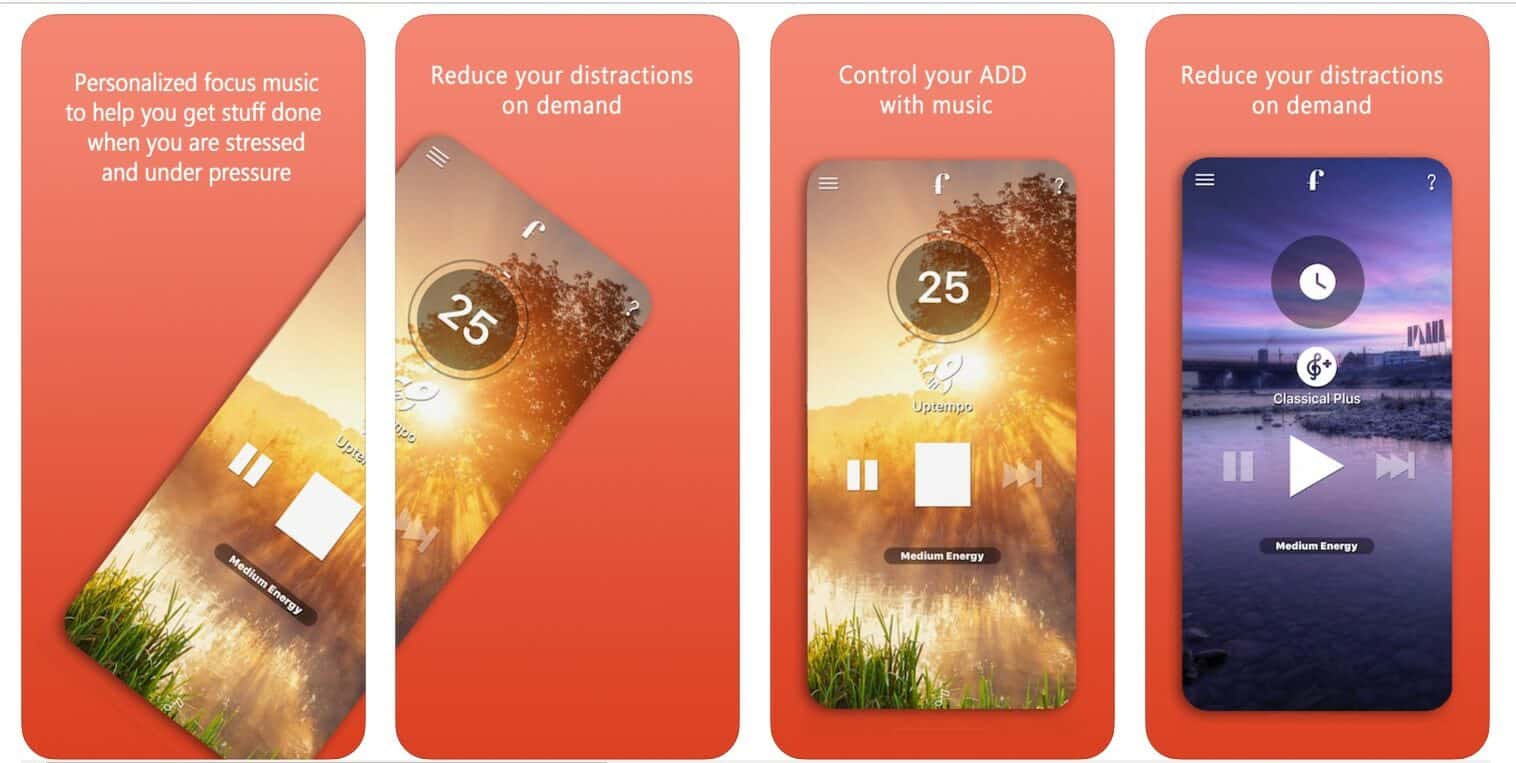 Based on neuroscience research, Focus@Will uses music to boost concentration and get you into a productivity flow. You can choose between different channels, ranging from Baroque piano and ambient music to Electro Bach and the funky beats of Alpha Chill. According to research, the app can extend your focus periods by 200-400%. It also offers a timer function and productivity tracker. A channel recommender helps you pick the right music for your needs, depending on your personality type, the kind of task you’re dealing with, and whether you're struggling with mental health issues such as ADHD. Focus@Will is available for both Android and iOS and as a web app. Subscriptions start at $69 annually. Get the app!
Based on neuroscience research, Focus@Will uses music to boost concentration and get you into a productivity flow. You can choose between different channels, ranging from Baroque piano and ambient music to Electro Bach and the funky beats of Alpha Chill. According to research, the app can extend your focus periods by 200-400%. It also offers a timer function and productivity tracker. A channel recommender helps you pick the right music for your needs, depending on your personality type, the kind of task you’re dealing with, and whether you're struggling with mental health issues such as ADHD. Focus@Will is available for both Android and iOS and as a web app. Subscriptions start at $69 annually. Get the app!
2. Focus To-Do
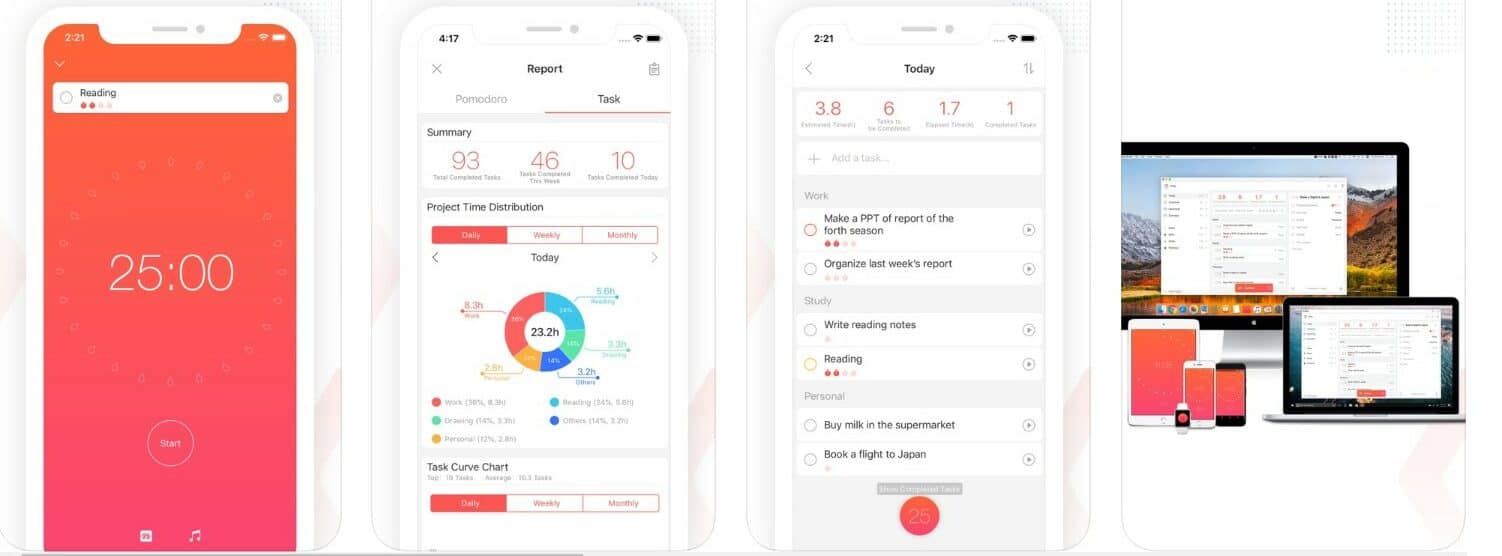 As a great stop procrastination app, Focus To-Do combines the Pomodoro technique with to-do list features. In case you haven't come across it before, Pomodoro is one of the most effective productivity techniques. It’s built around 25-minute work sessions interspersed with 5-minute breaks. Focus To-Do allows you to define tasks, including subtasks and recurring tasks, and assign deadlines. You can then work through the items on your list one-by-one using the Pomodoro technique. The app is available on all major platforms, including smartwatches. Your tasks will be synchronized across devices. The basic app is free, and premium plans start at $2.99 per month, with a lifetime license option priced at $8.99. Get the app!
As a great stop procrastination app, Focus To-Do combines the Pomodoro technique with to-do list features. In case you haven't come across it before, Pomodoro is one of the most effective productivity techniques. It’s built around 25-minute work sessions interspersed with 5-minute breaks. Focus To-Do allows you to define tasks, including subtasks and recurring tasks, and assign deadlines. You can then work through the items on your list one-by-one using the Pomodoro technique. The app is available on all major platforms, including smartwatches. Your tasks will be synchronized across devices. The basic app is free, and premium plans start at $2.99 per month, with a lifetime license option priced at $8.99. Get the app!
3. RescueTime
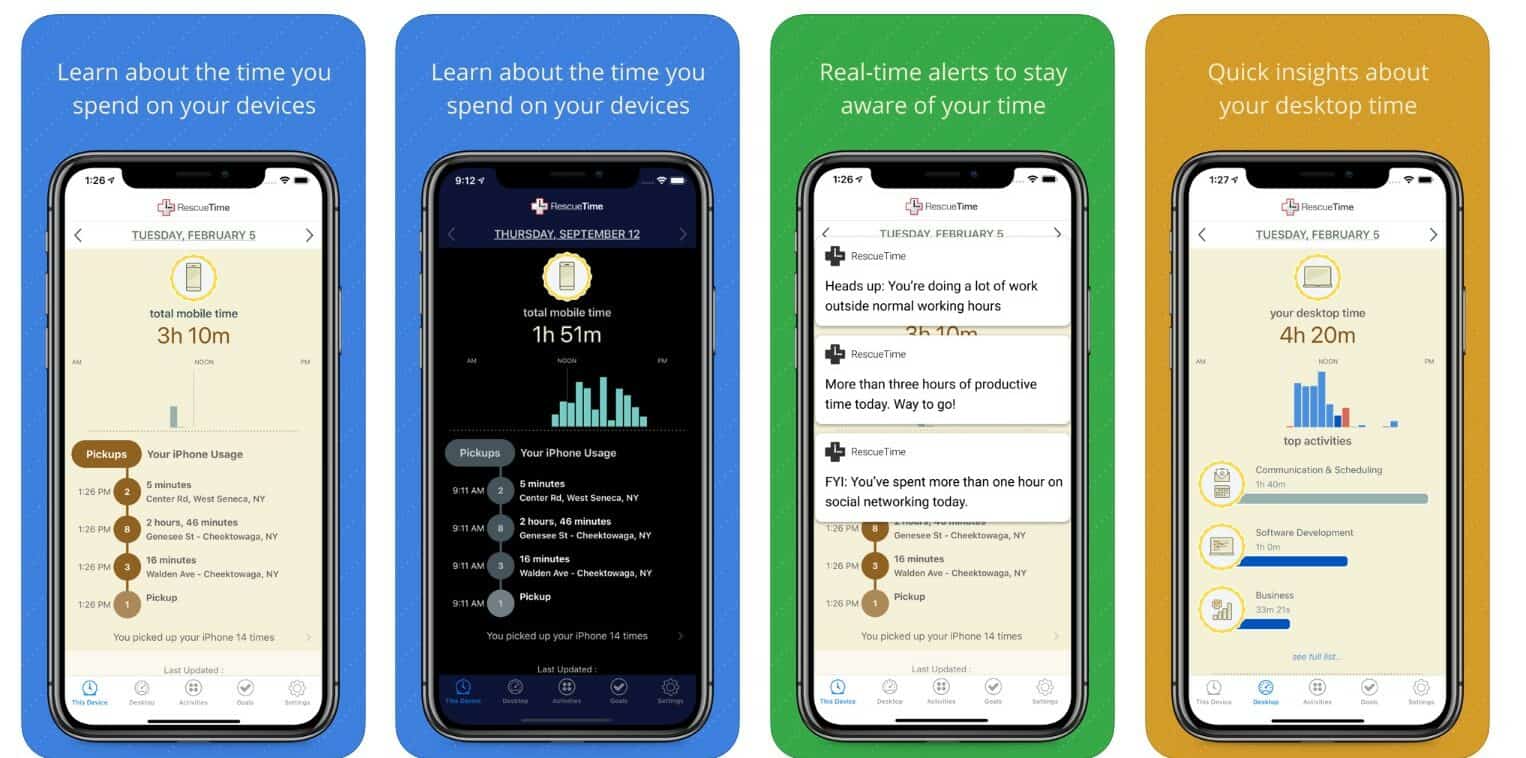 RescueTime boasts a rare 5.0 “outstanding” score by PCMag and is one of the most widely-used productivity tools popular with freelancers, designers, and developers((WP Beginner: 43 Top Tools for WordPress Freelancers, Designers, and Developers)). It automatically tracks the time you spend on various websites and applications, and classifies them into categories. Using this information, you can analyze where and when you are productive and what the major threats to your productivity are. More importantly, RescueTime allows you to summarily block out distractions, which is excellent for Pomodoro sessions. You can also set goals, such as spending less time on your emails or social media, and RescueTime will automatically assist you in reaching them. The app is available on all major platforms and offers a free lite version, and its premium plans start at $6.50/month (billed annually). It also integrates with a variety of other productivity tools, such as calendar apps and Slack. Get the app!
RescueTime boasts a rare 5.0 “outstanding” score by PCMag and is one of the most widely-used productivity tools popular with freelancers, designers, and developers((WP Beginner: 43 Top Tools for WordPress Freelancers, Designers, and Developers)). It automatically tracks the time you spend on various websites and applications, and classifies them into categories. Using this information, you can analyze where and when you are productive and what the major threats to your productivity are. More importantly, RescueTime allows you to summarily block out distractions, which is excellent for Pomodoro sessions. You can also set goals, such as spending less time on your emails or social media, and RescueTime will automatically assist you in reaching them. The app is available on all major platforms and offers a free lite version, and its premium plans start at $6.50/month (billed annually). It also integrates with a variety of other productivity tools, such as calendar apps and Slack. Get the app!
4. Forest
 As a gamified stop procrastinating app, Forest is a great way to motivate yourself to stay focused. Each time you start a focus session, you plant a tree in the app. While you work, it will grow on your screen. However, if you leave the app during the session, your tree dies off. The goal is to motivate you to not use your phone, removing a significant source of distraction. By completing your focus sessions, you can grow an entire forest over time. This isn’t just visually appealing, but an uplifting representation of how much work you've managed to get done. Your forest has a real-life impact as well. The larger you grow it, the more “coins” you can earn in the app. And using those, the app team plants actual trees. Forest is available on iOS, Android, and as a Firefox extension. It’s $1.99, with optional in-app purchases. Get the app!
As a gamified stop procrastinating app, Forest is a great way to motivate yourself to stay focused. Each time you start a focus session, you plant a tree in the app. While you work, it will grow on your screen. However, if you leave the app during the session, your tree dies off. The goal is to motivate you to not use your phone, removing a significant source of distraction. By completing your focus sessions, you can grow an entire forest over time. This isn’t just visually appealing, but an uplifting representation of how much work you've managed to get done. Your forest has a real-life impact as well. The larger you grow it, the more “coins” you can earn in the app. And using those, the app team plants actual trees. Forest is available on iOS, Android, and as a Firefox extension. It’s $1.99, with optional in-app purchases. Get the app!
5. Rocket 135
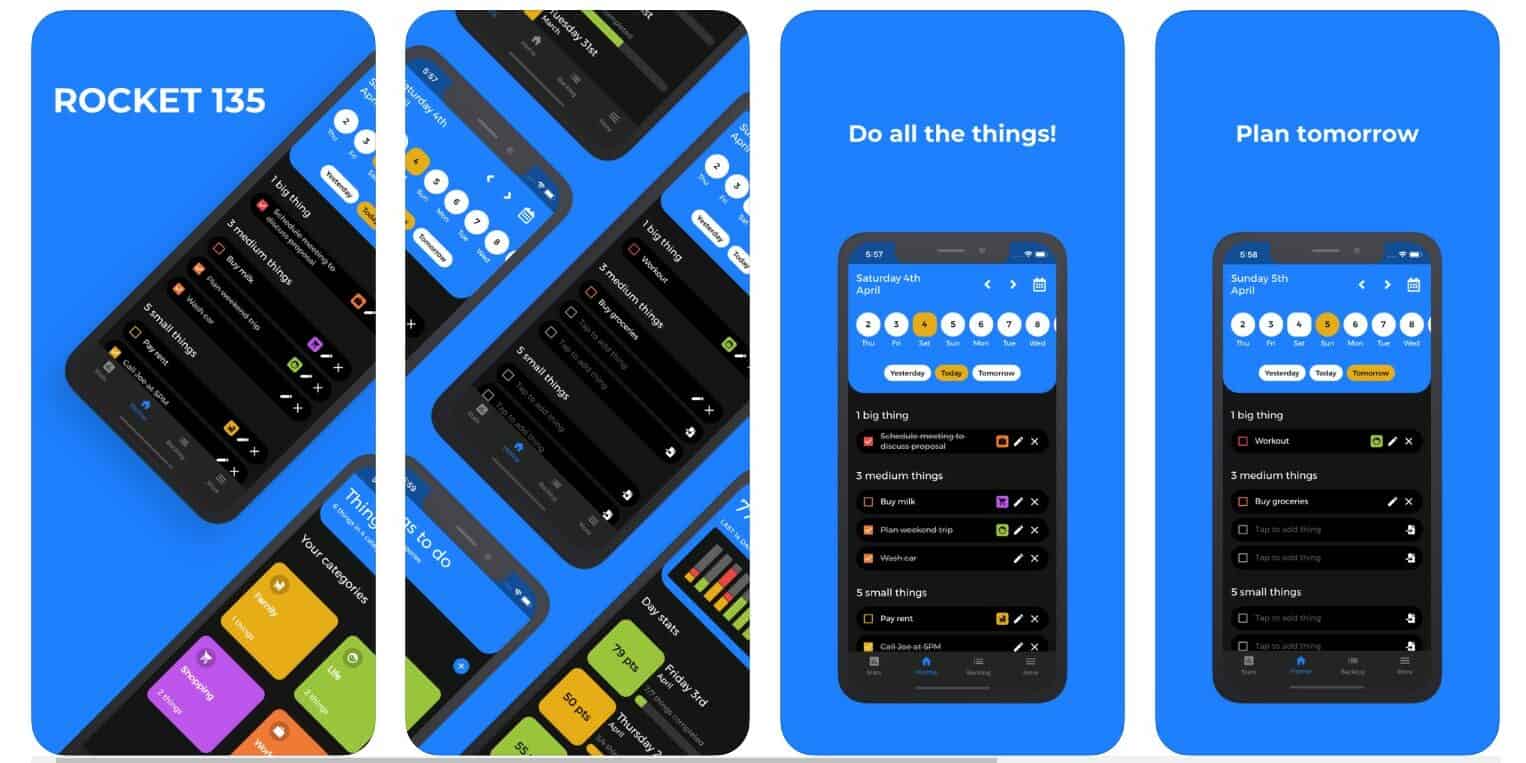 For those overwhelmed by to-do lists, Rocket 135 allows you to prioritize your tasks. Rather than having to face multiple stressful, anxiety-inducing tasks per day, you pick one important project, three of medium importance, and five of low importance to complete. This app lets you customize basic list types, archive tasks, assign them to themes, and collaborate with other users. It synchronizes across devices and offers a limited free version. The premium version is available at $2.50 monthly or $25 annually. Get the app!
For those overwhelmed by to-do lists, Rocket 135 allows you to prioritize your tasks. Rather than having to face multiple stressful, anxiety-inducing tasks per day, you pick one important project, three of medium importance, and five of low importance to complete. This app lets you customize basic list types, archive tasks, assign them to themes, and collaborate with other users. It synchronizes across devices and offers a limited free version. The premium version is available at $2.50 monthly or $25 annually. Get the app!
6. CARROT To-Do
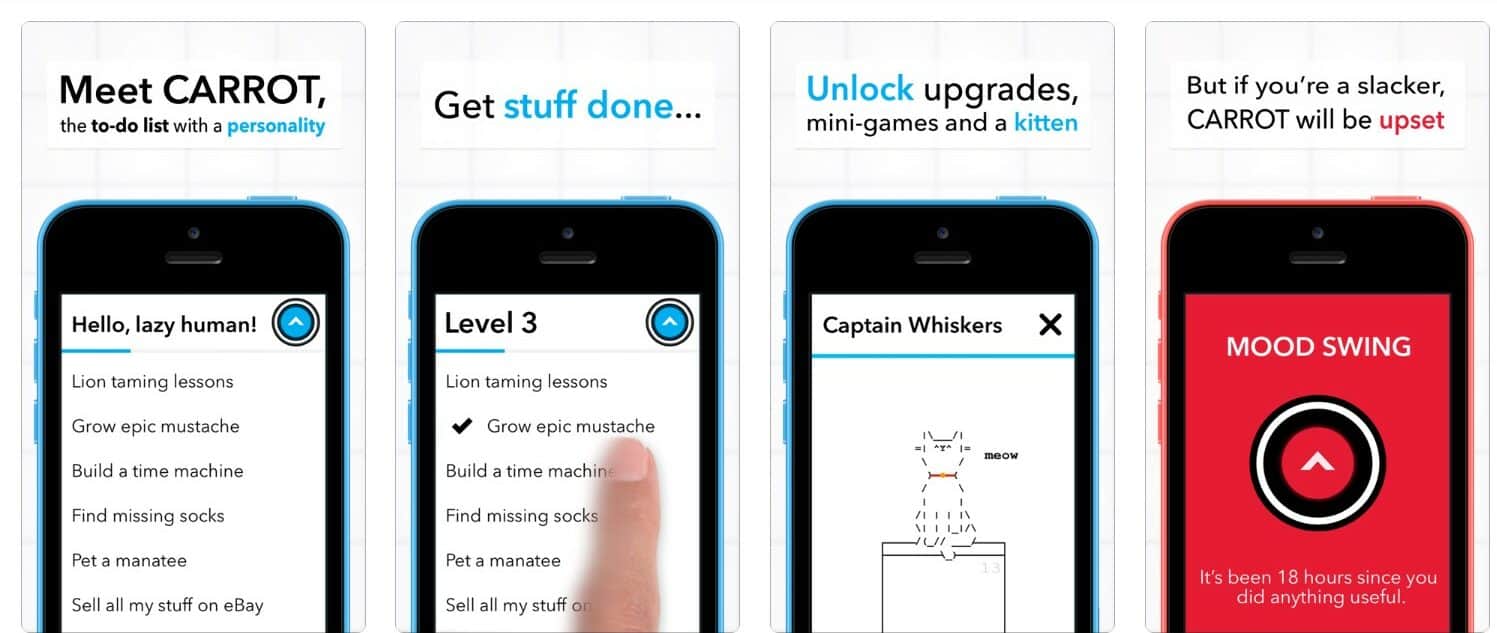 Like Forest, CARROT To-Do is an iOS app that turns productivity into a game to beat procrastination. You can set yourself a simple to-do list and get rewarded with “fortune cookies” and several hundred unique rewards for completed tasks. But beware! Fail to complete your tasks, and you will lose your rewards or be leveled down. A unique feature of CARROT's is that it is branded as having a personality, with an attitude to match. “I am your new taskmaster,” it declares. The app comes at a one-time cost of $2.99, with some in-app purchases for different themes and icons. Get the app!
Like Forest, CARROT To-Do is an iOS app that turns productivity into a game to beat procrastination. You can set yourself a simple to-do list and get rewarded with “fortune cookies” and several hundred unique rewards for completed tasks. But beware! Fail to complete your tasks, and you will lose your rewards or be leveled down. A unique feature of CARROT's is that it is branded as having a personality, with an attitude to match. “I am your new taskmaster,” it declares. The app comes at a one-time cost of $2.99, with some in-app purchases for different themes and icons. Get the app!
7. Freedom
 If gamification isn’t your style, Freedom is a stop procrastinating app that offers a somewhat harsher approach to battling procrastination. It will block distracting apps and websites—synced across all your devices. It's even possible to shut the internet out entirely if you have to focus on an offline project. The app can be downloaded for Mac and Windows, or installed as an extension for Chrome, Firefox, and Opera. iOS and Android apps are also available. Premium plans start at $2.42/month (billed annually). Get the app!
If gamification isn’t your style, Freedom is a stop procrastinating app that offers a somewhat harsher approach to battling procrastination. It will block distracting apps and websites—synced across all your devices. It's even possible to shut the internet out entirely if you have to focus on an offline project. The app can be downloaded for Mac and Windows, or installed as an extension for Chrome, Firefox, and Opera. iOS and Android apps are also available. Premium plans start at $2.42/month (billed annually). Get the app!
8. Momentum
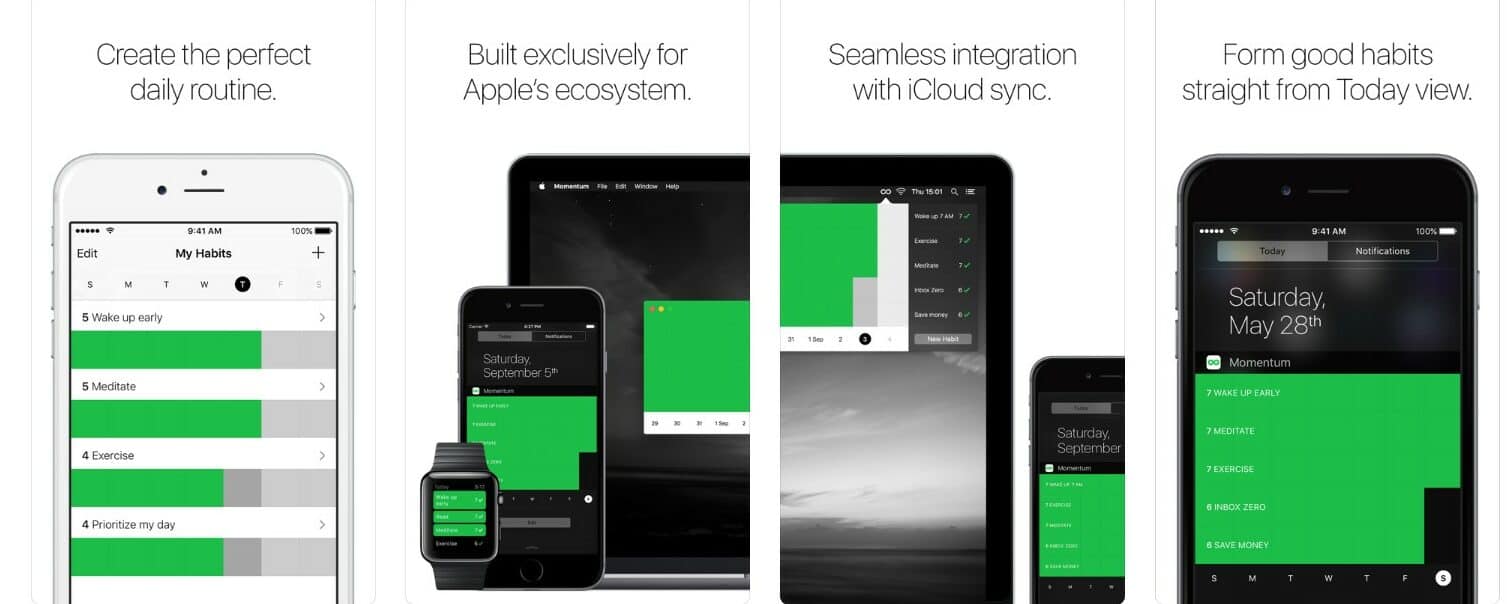 With an aesthetic approach to productivity, Momentum is sure to keep you focused. This browser extension for Chrome, Firefox, and Edge combines beautiful nature wallpapers, a distraction-free time display, inspirational quotes, and a prioritized to-do list. In the free version of the app, you can set yourself daily priorities and other tasks. The premium option, at $3.33/month, also includes a Pomodoro timer and syncs with popular task managers. Momentum is perfect for arriving at work after a stressful commute, or for creating an atmospheric setting in your (home) office. Get the app!
With an aesthetic approach to productivity, Momentum is sure to keep you focused. This browser extension for Chrome, Firefox, and Edge combines beautiful nature wallpapers, a distraction-free time display, inspirational quotes, and a prioritized to-do list. In the free version of the app, you can set yourself daily priorities and other tasks. The premium option, at $3.33/month, also includes a Pomodoro timer and syncs with popular task managers. Momentum is perfect for arriving at work after a stressful commute, or for creating an atmospheric setting in your (home) office. Get the app!
9. Take a Five
 Breaks are essential. Unfortunately, they are also procrastination pitfalls. A quick five-minute breather can only too easily turn into an hour wasted on Facebook. This stop procrastinating app, Take a Five, helps you avoid that. You set a timer for however long you want your break to be and open a tab. Once your time is up, the app will automatically close this tab and remind you to go back to work. No more going down scrolling rabbit holes. Take a Five is available for free as a web app. Get the app!
Breaks are essential. Unfortunately, they are also procrastination pitfalls. A quick five-minute breather can only too easily turn into an hour wasted on Facebook. This stop procrastinating app, Take a Five, helps you avoid that. You set a timer for however long you want your break to be and open a tab. Once your time is up, the app will automatically close this tab and remind you to go back to work. No more going down scrolling rabbit holes. Take a Five is available for free as a web app. Get the app!
10. Mindly
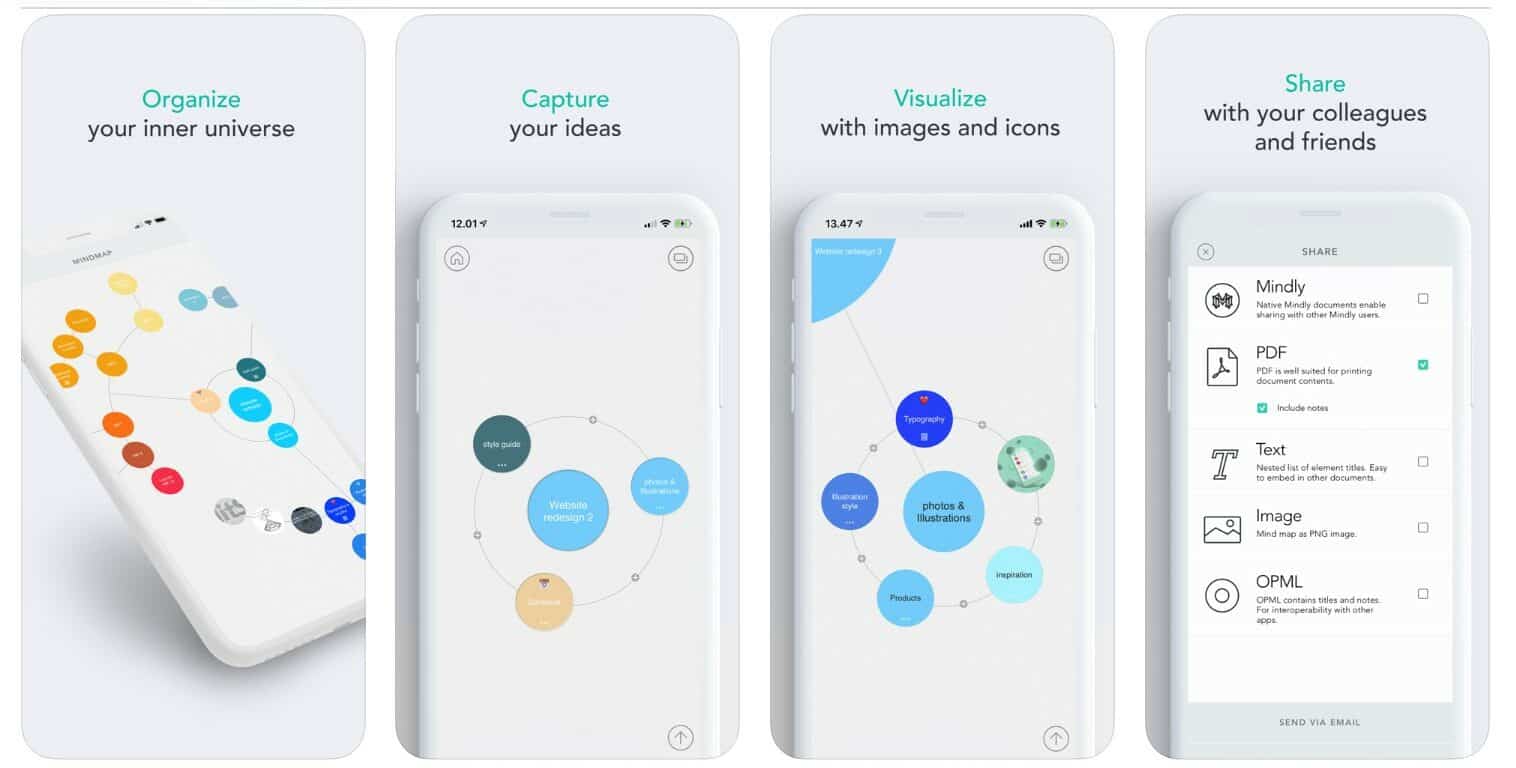 If a single look at your growing, deadline-laden to-do list sends you into a cold sweat, Mindly is the solution for you. This app helps you organize the deadlines, lists, and reminders cluttering your mind in a three-dimensional manner. You can create an infinite number of circles that connect related ideas and projects. Each circle can be color-coded, tagged with summaries, and annotated with emojis. Harnessing the power of associations, you can keep your inner universe organized. Mindly syncs across devices. It offers a limited free version for Android and iOS that can be upgraded to premium for a one-time $6.99. Furthermore, a desktop app is available for Mac at $29.99. Get the app!
If a single look at your growing, deadline-laden to-do list sends you into a cold sweat, Mindly is the solution for you. This app helps you organize the deadlines, lists, and reminders cluttering your mind in a three-dimensional manner. You can create an infinite number of circles that connect related ideas and projects. Each circle can be color-coded, tagged with summaries, and annotated with emojis. Harnessing the power of associations, you can keep your inner universe organized. Mindly syncs across devices. It offers a limited free version for Android and iOS that can be upgraded to premium for a one-time $6.99. Furthermore, a desktop app is available for Mac at $29.99. Get the app!
Final Thoughts
Procrastination, once started, is hard to stop, but these apps can help you get back to being productive and completing all of those to-do lists you've been avoiding. Find which one works for you and get started with it today.More Tips on Stopping Procrastination
- How to Stop Procrastinating: 11 Practical Ways for Procrastinators
- 10 Best Ted Talks About Procrastination That Will Ignite Your Motivation
- 5 Types of Procrastination (And How To Fix Each of Them)
from Lifehack - Feed https://ift.tt/2X6xzox
Tuesday, July 28, 2020
How renegade protein interrupts brain cell function in Alzheimer's disease
from Healthy Aging News -- ScienceDaily https://ift.tt/304k4rk
Further evidence World Trade Center responders are at risk for dementia
from Healthy Aging News -- ScienceDaily https://ift.tt/3jHqjci
How to Start Taking Action on Your Dreams Now
1. Tell Your Story
Your life story is unique and has brought you here today. The next chapter of your life is in your power to write and to realize. Not everything that happens to you is in your control((Forbes: 6 Ways To Stop Stressing About Things You Can't Control)), but the actions you take and how you choose to feel about what happens are in your control. Finding out what our future lives and dream lives might look like can be done effectively through the eyes of our childhood selves. Can you remember what you loved to do most as a child? Maybe you enjoyed collecting things like me–I always had a collection of pebbles in a carrier bag that smelled of seawater nestled under my bed. Perhaps you loved taking care of your pets: I had a dog, a tortoise, and many guinea pigs. Or maybe you were really great at making stuff. You can use the instincts, passions, and skills you had as a child to fuel your progress toward your adult dreams. I’m inviting you to really think about what you wanted to be when you grew up((CNN: What's the perfect job for you? Ask your five-year-old self)) and the memorable activities you enjoyed as a child, the ones that gave you a real sense of freedom and excitement, or the pursuits that you truly lost yourself in. What we call getting into our flow state((BBC: The ‘flow state’: Where creative work thrives)) as an adult is what came naturally to us as children. So, go back there now and think about how that felt. It may clue you in to what still remains true and important to you today.2. Define Your Dream
The first secret when you want to take action on your dreams is to know what they are. This sounds obvious, but so many people only have a loose definition, such as: "more free time," or "more money." Busy people know there is something else to life apart from slaving away for a job, or a boss they don’t like, but if you’re too busy to even know what your dream looks like, how can you make it come true? Once again, I’d invite you to connect to the optimism and playfulness of your childhood self. Go back to thinking about what your dreams involved at age seven or eight. Some of those may still be what you want today. Now write down what it is that you want and when you want to achieve it. Note down how you’ll know when you’ve got there and made this dream come true. How will you measure your success? Be as specific about your goals as you can. A study at the Dominican University in California((Dominican University: Goals Research Summary)) proved that writing down your goals, accountability, and commitment are three key ingredients to successfully achieving our goals.3. Picture Your Dream Coming True
Think about exactly how it will feel when you do achieve your dream. The sense of freedom and excitement. What will it look like, smell like, taste like. Imagine it in as much detail as you can. If you’re finding it hard to imagine a different life, imagine a childhood memory with all its sensations. As a little girl, I loved to ice-skate, making huge swirly patterns across clean expanses of beautiful glistening ice. The feeling of freedom, of trust in myself to balance, of speed. It felt very immersive, the coldness and my breath turning into little clouds in front of my face. Rosy cheeks and the happy ache of my legs afterwards. Imagine a childhood memory like this, then imagine the future you want, with as much detail and attention paid to how it looks, feels, tastes, smells and sounds. Draw, paint, speak, or write your future story. If you loved to create pictures like I did as a child, or write stories, or play on the computer, use your natural creative skills and what you love doing to map out your exciting future. You could create a picture, vision board, written story, or audio file. Remember to include specifics. What is your dream exactly? What does it look and feel like, and how will you know when you’ve reached it? Let’s put that future story somewhere you can easily access it. Make sure that you include a timescale for when you want to achieve this dream by, how you will measure your success, and what you need to get there. If possible, start breaking your dream down into small, manageable steps.4. What Part Do You Play?
You can’t control everything, so you need to be realistic about your role in making your future dreams come true when you really want to take action on your dreams. Think about where you need help. Once again, go back to childhood. We were not afraid to ask for help from a parent, friend, or sibling to realize our dreams and plans. Whatever we needed, our eager and enthusiastic childhood selves would reach out for support. We’d be resourceful with whatever we had to make our creative ideas a reality. As adults we also need to ask for support and help, and at the same time to notice what is in our control and what we can do to take action towards our dreams.5. Who Can Support You?
If you’ve noticed you need a bit of help, then get the gang together. Which friends can cheer you on and which can connect you? Who in your family will indulge in your dreams with you? What about the pragmatic ones who might help you work out what you need to get there? Whether you need someone to check in on you and see how you’re progressing, or need a buddy to brainstorm with to help the ideas flow, bring a few of your friends into the plan to help you move forward.6. Ensure Your Dream Is Realistic
Maybe the dream you’ve outlined just feels impossible. It costs too much or will take too much time to achieve. Instead of telling yourself "no, but," try the "yes, and" approach. This is much more representative of how a child’s mind works. When we were little, we weren’t scared to fail as failing was not a concept to us back then. Let’s harness some of that kid energy and see how "yes, and" can move us forward when our dream feels unrealistic. Let’s look at an example: maybe your dream is to have a hit record, and you think you can’t sing, or you don’t believe you have any musical talent. Instead of closing that down, if we "yes, and" it, we can say: “I want to have a hit record. Yes, and there are so many ways to achieve that. Some people have a hit record by working for a music business, and others might design the cover art. Some people speak on records instead of singing… yes, and someone has to write the lyrics or have the idea for the song. Yes, and I know someone who organizes a choir every Christmas at their local bar, and everyone in the bar is on the record. That amateur choir even got on TV as it was so much fun and all the money went to charity.” So, before you decide your idea is unrealistic, try "yes, and-ing" it to see how you can take action on your dreams, even if you think it sounds impossible!7. Use Small Wins and Rewards
On your journey toward achieving your dream, there will be small wins and important milestones; it’s not just about going straight to the destination. Measuring your progress is important and can be a chance to celebrate. Finding a way to measure it that is visible can really help. Whether it’s a chart or an app, whatever you choose, following and celebrating your progress is key, and celebrating that win is part of the joy. Being in the process and on the journey is just as important as reaching your target. Celebrate with the happiness of a small child…do a dance, take a photo, tell your friends.8. Update the Map
You might find the plan you made isn’t working for some reason. Things have changed, and your goals and targets are not working out for you. That’s ok! Let’s look at how you can change things up and put new life and energy into the project. Take it apart and put it back together again. Define the new plan and the new goals, and start on the next phase of the journey, equipped with the knowledge and learning from what didn’t work.9. Make Space
Achieving our dreams might mean losing something else, and that’s ok. It could be a literal swap, such as giving up wine to save money towards the goal. Or it could be something more ideological, like giving up saying yes to everything to make more time to focus on your pursuits. Think about what you can give up to make space for your dreams.10. Use Your Superpower
What’s your superpower? Use this to take action on your dreams today! Perhaps you’re awesome at using your network to find solutions to problems. If that sounds like you, then consider picking up the phone and start asking for some ideas and connections. If you prefer to research, get reading or watching TED talks and presentations to find practical ways to achieve your particular dream. Who else has overcome a similar problem? How did they do it? What can you borrow from what they learned, and what can you learn from how they won or lost along the way?11. Keep Your Energy up
Remember to take a rest and recharge on the journey towards your dreams. Take breaks, eat and sleep well, exercise, and listen to and tune in to what your body and mind needs to thrive.Final Thoughts
Achieving your dreams is unlikely to be an overnight task. It’s more likely to be a winding road with setbacks, lessons, obstacles, and new discoveries. Enjoy the journey! It might take years, but every step, no matter how tiny, can be enjoyed, even the struggles. Maintaining a mindset around enjoying the journey will really equip you to thrive and see those ambitious dreams become a reality.More to Get You to Take Action Towards Your Dreams
- How to Get Yourself to Take Action Towards Your Goal
- How to Take Smart and Massive Action in 6 Simple Steps
- 10 Ways To Turn Your Big Dream Into Reality
from Lifehack - Feed https://ift.tt/2DbfwX6
Texas Couple Married for 46 Years Beats COVID-Cancer-Chemo Crisis And Returns Home with Clean Bills of Health
One couple’s love and commitment through impossible-to-imagine circumstances gives a whole new meaning to the phrase ‘to have and to hold in sickness and in health’. On top of being diagnosed with ovarian and breast cancer, Janice Beecham and her husband of 46 years had to battle through COVID-19 quarantines—but they came out the other […]
The post Texas Couple Married for 46 Years Beats COVID-Cancer-Chemo Crisis And Returns Home with Clean Bills of Health appeared first on Good News Network.
from Good News Network https://ift.tt/304waAO
How to Start Taking Action on Your Dreams Now
1. Tell Your Story
Your life story is unique and has brought you here today. The next chapter of your life is in your power to write and to realize. Not everything that happens to you is in your control((Forbes: 6 Ways To Stop Stressing About Things You Can't Control)), but the actions you take and how you choose to feel about what happens are in your control. Finding out what our future lives and dream lives might look like can be done effectively through the eyes of our childhood selves. Can you remember what you loved to do most as a child? Maybe you enjoyed collecting things like me–I always had a collection of pebbles in a carrier bag that smelled of seawater nestled under my bed. Perhaps you loved taking care of your pets: I had a dog, a tortoise, and many guinea pigs. Or maybe you were really great at making stuff. You can use the instincts, passions, and skills you had as a child to fuel your progress toward your adult dreams. I’m inviting you to really think about what you wanted to be when you grew up((CNN: What's the perfect job for you? Ask your five-year-old self)) and the memorable activities you enjoyed as a child, the ones that gave you a real sense of freedom and excitement, or the pursuits that you truly lost yourself in. What we call getting into our flow state((BBC: The ‘flow state’: Where creative work thrives)) as an adult is what came naturally to us as children. So, go back there now and think about how that felt. It may clue you in to what still remains true and important to you today.2. Define Your Dream
The first secret when you want to take action on your dreams is to know what they are. This sounds obvious, but so many people only have a loose definition, such as: "more free time," or "more money." Busy people know there is something else to life apart from slaving away for a job, or a boss they don’t like, but if you’re too busy to even know what your dream looks like, how can you make it come true? Once again, I’d invite you to connect to the optimism and playfulness of your childhood self. Go back to thinking about what your dreams involved at age seven or eight. Some of those may still be what you want today. Now write down what it is that you want and when you want to achieve it. Note down how you’ll know when you’ve got there and made this dream come true. How will you measure your success? Be as specific about your goals as you can. A study at the Dominican University in California((Dominican University: Goals Research Summary)) proved that writing down your goals, accountability, and commitment are three key ingredients to successfully achieving our goals.3. Picture Your Dream Coming True
Think about exactly how it will feel when you do achieve your dream. The sense of freedom and excitement. What will it look like, smell like, taste like. Imagine it in as much detail as you can. If you’re finding it hard to imagine a different life, imagine a childhood memory with all its sensations. As a little girl, I loved to ice-skate, making huge swirly patterns across clean expanses of beautiful glistening ice. The feeling of freedom, of trust in myself to balance, of speed. It felt very immersive, the coldness and my breath turning into little clouds in front of my face. Rosy cheeks and the happy ache of my legs afterwards. Imagine a childhood memory like this, then imagine the future you want, with as much detail and attention paid to how it looks, feels, tastes, smells and sounds. Draw, paint, speak, or write your future story. If you loved to create pictures like I did as a child, or write stories, or play on the computer, use your natural creative skills and what you love doing to map out your exciting future. You could create a picture, vision board, written story, or audio file. Remember to include specifics. What is your dream exactly? What does it look and feel like, and how will you know when you’ve reached it? Let’s put that future story somewhere you can easily access it. Make sure that you include a timescale for when you want to achieve this dream by, how you will measure your success, and what you need to get there. If possible, start breaking your dream down into small, manageable steps.4. What Part Do You Play?
You can’t control everything, so you need to be realistic about your role in making your future dreams come true when you really want to take action on your dreams. Think about where you need help. Once again, go back to childhood. We were not afraid to ask for help from a parent, friend, or sibling to realize our dreams and plans. Whatever we needed, our eager and enthusiastic childhood selves would reach out for support. We’d be resourceful with whatever we had to make our creative ideas a reality. As adults we also need to ask for support and help, and at the same time to notice what is in our control and what we can do to take action towards our dreams.5. Who Can Support You?
If you’ve noticed you need a bit of help, then get the gang together. Which friends can cheer you on and which can connect you? Who in your family will indulge in your dreams with you? What about the pragmatic ones who might help you work out what you need to get there? Whether you need someone to check in on you and see how you’re progressing, or need a buddy to brainstorm with to help the ideas flow, bring a few of your friends into the plan to help you move forward.6. Ensure Your Dream Is Realistic
Maybe the dream you’ve outlined just feels impossible. It costs too much or will take too much time to achieve. Instead of telling yourself "no, but," try the "yes, and" approach. This is much more representative of how a child’s mind works. When we were little, we weren’t scared to fail as failing was not a concept to us back then. Let’s harness some of that kid energy and see how "yes, and" can move us forward when our dream feels unrealistic. Let’s look at an example: maybe your dream is to have a hit record, and you think you can’t sing, or you don’t believe you have any musical talent. Instead of closing that down, if we "yes, and" it, we can say: “I want to have a hit record. Yes, and there are so many ways to achieve that. Some people have a hit record by working for a music business, and others might design the cover art. Some people speak on records instead of singing… yes, and someone has to write the lyrics or have the idea for the song. Yes, and I know someone who organizes a choir every Christmas at their local bar, and everyone in the bar is on the record. That amateur choir even got on TV as it was so much fun and all the money went to charity.” So, before you decide your idea is unrealistic, try "yes, and-ing" it to see how you can take action on your dreams, even if you think it sounds impossible!7. Use Small Wins and Rewards
On your journey toward achieving your dream, there will be small wins and important milestones; it’s not just about going straight to the destination. Measuring your progress is important and can be a chance to celebrate. Finding a way to measure it that is visible can really help. Whether it’s a chart or an app, whatever you choose, following and celebrating your progress is key, and celebrating that win is part of the joy. Being in the process and on the journey is just as important as reaching your target. Celebrate with the happiness of a small child…do a dance, take a photo, tell your friends.8. Update the Map
You might find the plan you made isn’t working for some reason. Things have changed, and your goals and targets are not working out for you. That’s ok! Let’s look at how you can change things up and put new life and energy into the project. Take it apart and put it back together again. Define the new plan and the new goals, and start on the next phase of the journey, equipped with the knowledge and learning from what didn’t work.9. Make Space
Achieving our dreams might mean losing something else, and that’s ok. It could be a literal swap, such as giving up wine to save money towards the goal. Or it could be something more ideological, like giving up saying yes to everything to make more time to focus on your pursuits. Think about what you can give up to make space for your dreams.10. Use Your Superpower
What’s your superpower? Use this to take action on your dreams today! Perhaps you’re awesome at using your network to find solutions to problems. If that sounds like you, then consider picking up the phone and start asking for some ideas and connections. If you prefer to research, get reading or watching TED talks and presentations to find practical ways to achieve your particular dream. Who else has overcome a similar problem? How did they do it? What can you borrow from what they learned, and what can you learn from how they won or lost along the way?11. Keep Your Energy up
Remember to take a rest and recharge on the journey towards your dreams. Take breaks, eat and sleep well, exercise, and listen to and tune in to what your body and mind needs to thrive.Final Thoughts
Achieving your dreams is unlikely to be an overnight task. It’s more likely to be a winding road with setbacks, lessons, obstacles, and new discoveries. Enjoy the journey! It might take years, but every step, no matter how tiny, can be enjoyed, even the struggles. Maintaining a mindset around enjoying the journey will really equip you to thrive and see those ambitious dreams become a reality.More to Get You to Take Action Towards Your Dreams
- How to Get Yourself to Take Action Towards Your Goal
- How to Take Smart and Massive Action in 6 Simple Steps
- 10 Ways To Turn Your Big Dream Into Reality
from Lifehack - Feed https://ift.tt/2DbfwX6
How to Take Personal Responsibility and Stop Blaming Circumstances
Personal Responsibility and Self-Actualization
Humans that are content, living as the best version of themselves and holding themselves accountable for their happiness are what psychologist Abraham Maslow calls living as "fully human." You’ve probably seen Maslow's famous hierarchy of needs pyramid((Simple Psychology: Maslow's Hierarchy of Needs)) somewhere in your life because it's a leading human behavior theory explaining the motivations behind us as humans. People have always struggled with the idea of "self-actualization" (i.e. being fully human) sitting at the top of the pyramid, making it appear like an unattainable peak that few will ever reach. However, that wasn't Maslow's intention; he didn’t actually create the pyramid. He wrote about a hierarchy, and someone else assumed it was a pyramid, and after all these years, we're finding out what he really meant."In this choppy surf, a clunky pyramid is of little use. Instead, what is needed is something a bit more functional. We’ll need a sailboat." -Scott Barry Kaufman((Kaufman: Transcend: The New Science of Self-Actualization))Humanistic psychologist Scott Barry Kaufman reworked and refreshed the pyramid based on the latest science in human behavior in his novel, Transcend: The New Science of Self-Actualization. Being fully human, Kaufman stressed, is about living in the moment, enjoying the ride, and doing what you love, because when you feel like you’re achieving your purpose, you feel aligned within yourself, and you’re able to make a meaningful contribution to the world. Sounds good, right? Well, here's how to edge closer to that stage.
Why You Need to Take Personal Responsibility
When you set sail, you don't set off without a direction or destination in mind, right? Life is the same, though a lot of us are out there living aimless lives and consequently falling prey to the grips of anxiety and depression. This is why it's super important to have an aim or direction, a North Star to head towards, which shouldn't be confused with materialistic goals, like getting rich or buying that house. If you've ever lived the "I'll be happy when" life, you'll know it's a tough lesson to learn when you find out that you never feel genuinely happy because the goalpost keeps moving. It's also key to make life decisions yourself because living someone else's life is a sure-fire way to end up unhappy. What you need to do is find a balance between deciding what direction will lead you to be your best self and making sure that you're enjoying everyday life."The hard part is really living in the moment and being able to sail through life without the end in mind. Just like it takes courage to open your sail on a sailboat and see where the winds will take you, it takes a lot of courage to become the best version of yourself." -Scott Barry Kaufman
What Is the Best Version of You?
Aiming to be the best version of yourself is all about acceptance. You need to be able to accept the good with the bad, accept the shadow, and all the things that hide and cower in the dark. Uncover the darkness by giving it some light. If you’ve had a rough childhood or suffered trauma, if you feel aimless or lost at sea, whatever it is, you have to accept a portion of responsibility for where you are. You’re not responsible for the beliefs you hold based on things people have told you, but you are responsible for dealing with them. People who take responsibility for their lives and their weaknesses, and choose to spend their life developing and improving on the healthy, positive aspects are the ones who show courage. Climb up the mast of your sailboat and rise above your own personal desires and feelings. You might just see that there are billions of other boats bobbing around out there, and some might need your help. But you can’t help them until you’ve helped yourself.How to Take Personal Responsibility
The road to learning how to take personal responsibility can be a difficult one, but start simple and then begin to tackle the more difficult aspects. Here are two steps you need to take based on the sailing metaphor we've been working with.1. Secure the Hull (and the Sailor)
Just like the ocean, our life has many ups and downs, ebbs and flows, but having a solid sailboat means you can withstand the weather and hold course without capsizing or filling with water. The hull represents your basic needs, your non-negotiables required for a safe journey, which are: safety, self-esteem, and connection with others. Check-in and ask yourself whether your basic needs are being met. Do you feel confident about who you are as a person? Do you struggle with willpower and motivation? Do you have enough connections with others? You need to ask these questions in order to know where your liabilities are. They apply to all of us, and they could be the reasons your current journey isn’t much fun.“No human being is exempt from the dire consequences of loneliness, and no other basic human need satisfaction can substitute for a deep connection.” -Abraham MaslowRemember: You only get one sailboat and one journey, so you've got to make it count.
2. Open and Strengthen Your Sails
Maslow was all about not focusing and stressing too much on the destination. Yes, head in the right direction, but focus on enjoying the sail by finding purpose, peak experiences, and following that desire to explore. When was the last time you took the courage to really open your sails? To be vulnerable and willing to fail? When was the last time you were in a flow state, in a moment where you were so engrossed in what you were doing that you forgot about your insecurities and worries, where you were just happy? Maslow believed we all had our own form of peak experience:“Whether an excellent athletic or music performance, creative experience, aesthetic perception, the love experience, sexual experience, childbirth, moments of insight and understanding, religious or mystical experience, or overcoming a profound challenge — it is any experience that comes close to perfection for that person.”Being fully human means that you seek out new, challenging, and uncertain events to further develop yourself. Wouldn’t it be nice to raise the tide for the other boats and seize amazing opportunities? Imagine if you could just forget all about what’s negative and just focus on being in the moment.
Final Thoughts
If you don’t remember the last time you felt truly happy, if you feel uninspired or lost, if you feel like you’re on the wrong path, then start with the basics. Make sure your basic needs are being met before you move closer to self-actualization. Look at the mistakes you've made it life, learn from them, and move on to doing bigger and better things. Once you learn how to live a life of personal responsibility, you'll find your compass naturally points you in the direction of happiness and success.More on Taking Personal Responsibility in Life
- Recognizing the Distinction Between Blame and Responsibility
- When You Take Full Responsibility Of Your Life, You’ll Find Success
- How to Stop Making Excuses And Start Taking Responsibility
from Lifehack - Feed https://ift.tt/3hHT1I9
Monday, July 27, 2020
19 Best To-Do List Apps to Keep You on Track in 2020
- How do you assign your tasks to the group?
- What is your task completion and notification process?
- Do you allow others to add additional details or like to keep the task details short?
- How do you keep a record of your tasks?
1. Todoist
 Todoist has been on the market for a long time now. However, its features aren’t out-of-date in any way. It offers various features to organize or add color-coded labeling to your task. The app is also beautifully designed. It allows you to create sub-tasks, projects, sub-projects and dependencies. You can even add deadlines to a particular project and label your lists with different colors. Moreover, Todoist has integrations with other services such as Sunrise Calendar, IFTTT, and Google Drive. Cost - Free | $3 per month or $29 per year Available on Web | Android | iOS | Windows | Chrome
Todoist has been on the market for a long time now. However, its features aren’t out-of-date in any way. It offers various features to organize or add color-coded labeling to your task. The app is also beautifully designed. It allows you to create sub-tasks, projects, sub-projects and dependencies. You can even add deadlines to a particular project and label your lists with different colors. Moreover, Todoist has integrations with other services such as Sunrise Calendar, IFTTT, and Google Drive. Cost - Free | $3 per month or $29 per year Available on Web | Android | iOS | Windows | Chrome
2. Any.do
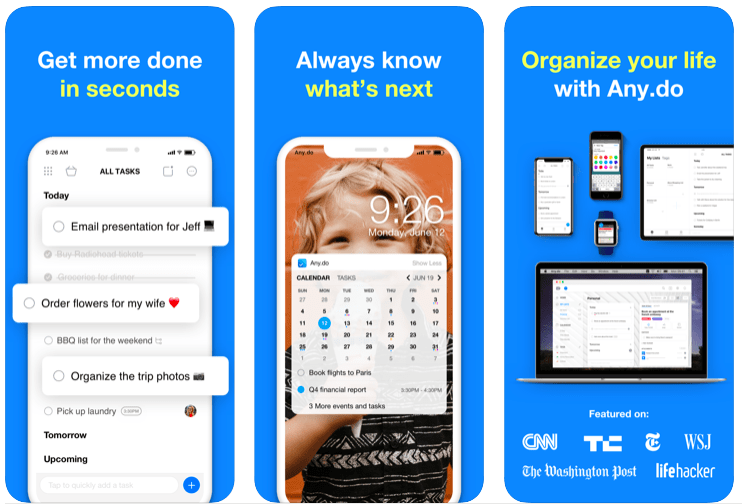 This is one of the most beautiful and well-designed apps on the list, Any.do offers a drag-and-drop interface with the ability to swipe tasks to mark them complete. But some of the key differentiators, like getting push notification in the morning about all the schedulings of the day, make it one of the preferred choices. Other features like deleting the task just by shaking your phone and adding tasks through voice command provide any.do a nice modern look and feel. Apart from its attractive and intuitive user interface, its integration with Alexa and Slack allow you to collaborate with ease. Cross-platform availability and superb scheduling assistant make this a perfect choice for effective task management. Cost - Free | Premium from $2.09/month Available on Web | Android | iOS | Chrome
This is one of the most beautiful and well-designed apps on the list, Any.do offers a drag-and-drop interface with the ability to swipe tasks to mark them complete. But some of the key differentiators, like getting push notification in the morning about all the schedulings of the day, make it one of the preferred choices. Other features like deleting the task just by shaking your phone and adding tasks through voice command provide any.do a nice modern look and feel. Apart from its attractive and intuitive user interface, its integration with Alexa and Slack allow you to collaborate with ease. Cross-platform availability and superb scheduling assistant make this a perfect choice for effective task management. Cost - Free | Premium from $2.09/month Available on Web | Android | iOS | Chrome
3. Microsoft To Do
 Previously, Microsoft had bought the popular to-do list app Wunderlist and it was concluded that the Redmond-based company will be focusing on it wholeheartedly. However, Microsoft has come up with a brand new to-do list app, Microsoft To Do, and the future of Wunderlist is uncertain Microsoft To Do, as mentioned earlier, is a brand new task scheduling app, which offers almost all the features of an ideal to-do list app. Its intuitive UI and themed structure provide smooth and efficient task scheduling. As offered by Microsoft, the app is fully compatible with Windows 10 and offers a UWP supported app in the Windows store. Cost - Free Available on Web | Android | iOS | Windows
Previously, Microsoft had bought the popular to-do list app Wunderlist and it was concluded that the Redmond-based company will be focusing on it wholeheartedly. However, Microsoft has come up with a brand new to-do list app, Microsoft To Do, and the future of Wunderlist is uncertain Microsoft To Do, as mentioned earlier, is a brand new task scheduling app, which offers almost all the features of an ideal to-do list app. Its intuitive UI and themed structure provide smooth and efficient task scheduling. As offered by Microsoft, the app is fully compatible with Windows 10 and offers a UWP supported app in the Windows store. Cost - Free Available on Web | Android | iOS | Windows
4. Habitica
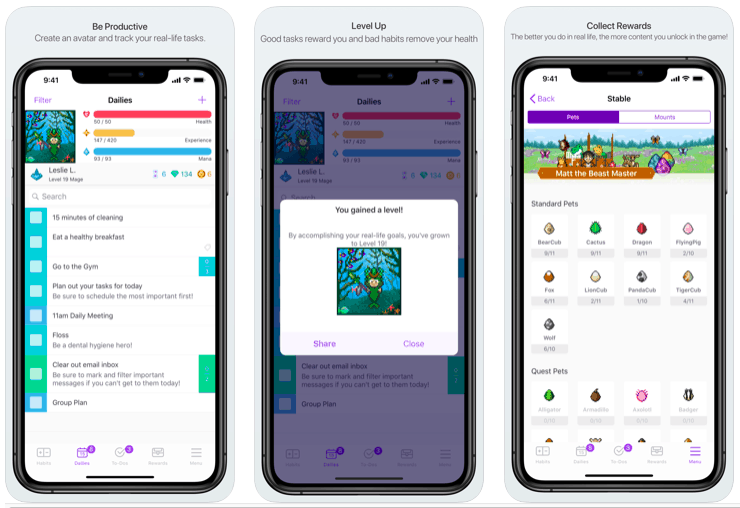 Habitica is an habit-building app, which is available on major platforms like Android and iOS. It beautifully gamifies your life by turning tasks and to-do lists into a role-playing game. You can buy different weapons and level yourself up by crossing tasks off your list. However, your character loses powers and health if you ignore tasks or fail to complete them in the decided timeframe. That’s not all. The app provides an extremely useful feature for sharing your tasks with your friends and brings competitiveness into the whole task completion process. Cost - Free Available on Web | Android | iOS | Chrome
Habitica is an habit-building app, which is available on major platforms like Android and iOS. It beautifully gamifies your life by turning tasks and to-do lists into a role-playing game. You can buy different weapons and level yourself up by crossing tasks off your list. However, your character loses powers and health if you ignore tasks or fail to complete them in the decided timeframe. That’s not all. The app provides an extremely useful feature for sharing your tasks with your friends and brings competitiveness into the whole task completion process. Cost - Free Available on Web | Android | iOS | Chrome
5. Google Keep
 Google, for a long time, has been struggling to produce a better productive app. With Google Keep, it has successfully delivered a competitive app to the market. Google Keep is a simple note-taking and to-do list app. It offers simple and intuitive functionality with colored labeling and team sharing. Moreover, as a Google product, Google Keep is fully integrated with other Google offerings such as Google Docs and Gmail, which makes it extremely helpful. You can share your Google Keep notes with team members to work in collaboration on small projects. Google Keep will automatically display working notes or lists for a particular task until you archive it or are done working with it, which makes arranging all your lists extremely easy. Cost - Free Available on Web | Android | iOS | Chrome
Google, for a long time, has been struggling to produce a better productive app. With Google Keep, it has successfully delivered a competitive app to the market. Google Keep is a simple note-taking and to-do list app. It offers simple and intuitive functionality with colored labeling and team sharing. Moreover, as a Google product, Google Keep is fully integrated with other Google offerings such as Google Docs and Gmail, which makes it extremely helpful. You can share your Google Keep notes with team members to work in collaboration on small projects. Google Keep will automatically display working notes or lists for a particular task until you archive it or are done working with it, which makes arranging all your lists extremely easy. Cost - Free Available on Web | Android | iOS | Chrome
6. Google Tasks
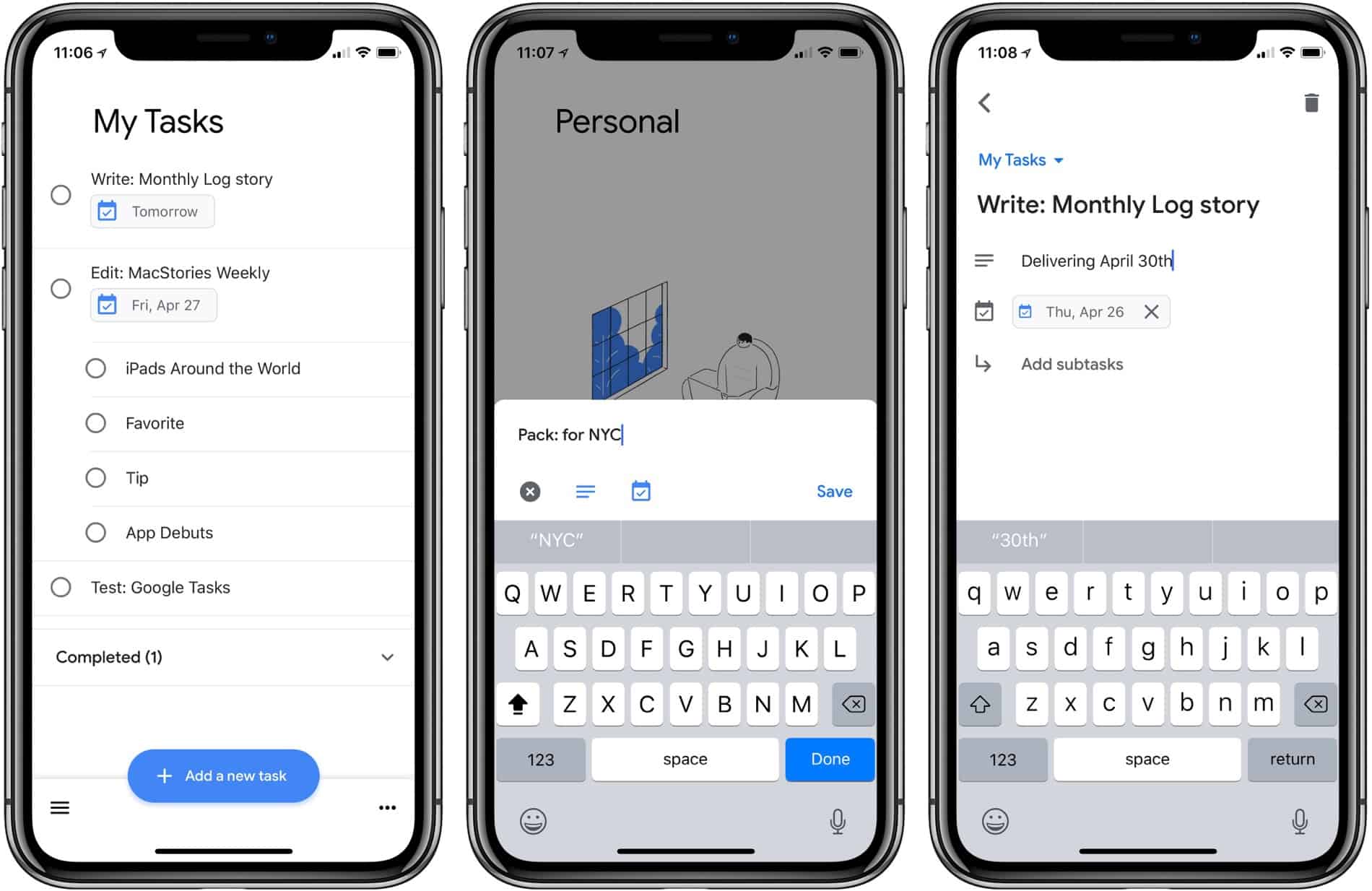 Google Tasks is a newly released task scheduling app from Google, which is fully integrated with Gmail, Google Calendar and other productive apps offered by Google. A simple and intuitive app with Google’s material design, Google Tasks let you add tasks in Gmail without opening a new window on your desktop. This proves extremely helpful when you need to add an email as a task and be reminded about it later. Google Tasks, which is also available for free on Android and iOS e, allows you to check your schedule on your mobile devices and stay updated at every step. Cost - Free Available on Android | iOS
Google Tasks is a newly released task scheduling app from Google, which is fully integrated with Gmail, Google Calendar and other productive apps offered by Google. A simple and intuitive app with Google’s material design, Google Tasks let you add tasks in Gmail without opening a new window on your desktop. This proves extremely helpful when you need to add an email as a task and be reminded about it later. Google Tasks, which is also available for free on Android and iOS e, allows you to check your schedule on your mobile devices and stay updated at every step. Cost - Free Available on Android | iOS
7. GTasks
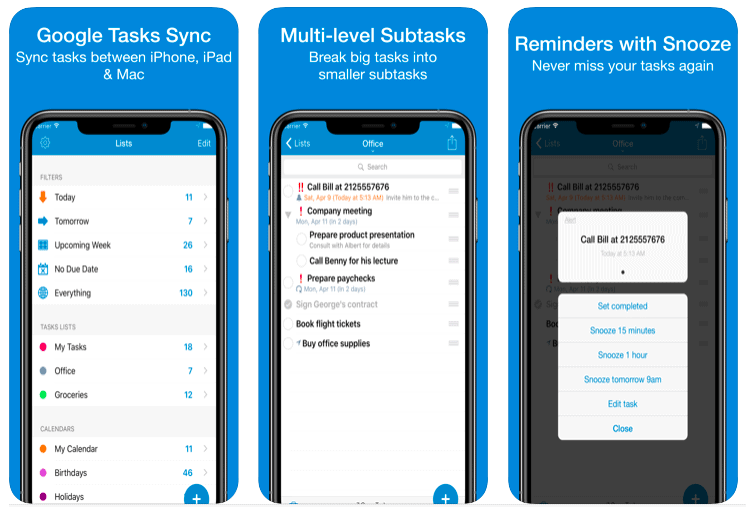 GTasks is one of the most popular and highly rated to-do list apps on Google Play. While the app is available to download for free, users are able to make various in-app purchases. The free version offers some shiny features such as Google Tasks sync, widgets, and voice-enabled task scheduling. The pro version, on the other hand, offers additional security with a pattern lock, task scheduling with Google Now, and many others. GTasks is best for people who are looking for a simple but effective to-do list app. Cost - Free (in-app purchases) Available on Android | iOS
GTasks is one of the most popular and highly rated to-do list apps on Google Play. While the app is available to download for free, users are able to make various in-app purchases. The free version offers some shiny features such as Google Tasks sync, widgets, and voice-enabled task scheduling. The pro version, on the other hand, offers additional security with a pattern lock, task scheduling with Google Now, and many others. GTasks is best for people who are looking for a simple but effective to-do list app. Cost - Free (in-app purchases) Available on Android | iOS
8. Memorigi
 Memorigi, a brand new to-do list app not only presents a nice and intuitive material design UI. It also offers some extremely useful features like cloud sync, reminders, and weather integration, which provides you with real-time weather information. Although it may take time to familiarize yourself with the app’s unique horizontal structure, the Facebook Messenger-like floating chat heads for each to-do list improves the flexibility of adding tasks. Memorigi’s free version should be enough for most users as it offers almost all the features necessary for basic task scheduling. However, you can opt for the premium plan which starts from $1.99 per month. Cost - Free | Starts from $1.99 per month Available on Android
Memorigi, a brand new to-do list app not only presents a nice and intuitive material design UI. It also offers some extremely useful features like cloud sync, reminders, and weather integration, which provides you with real-time weather information. Although it may take time to familiarize yourself with the app’s unique horizontal structure, the Facebook Messenger-like floating chat heads for each to-do list improves the flexibility of adding tasks. Memorigi’s free version should be enough for most users as it offers almost all the features necessary for basic task scheduling. However, you can opt for the premium plan which starts from $1.99 per month. Cost - Free | Starts from $1.99 per month Available on Android
9. OmniFocus 3
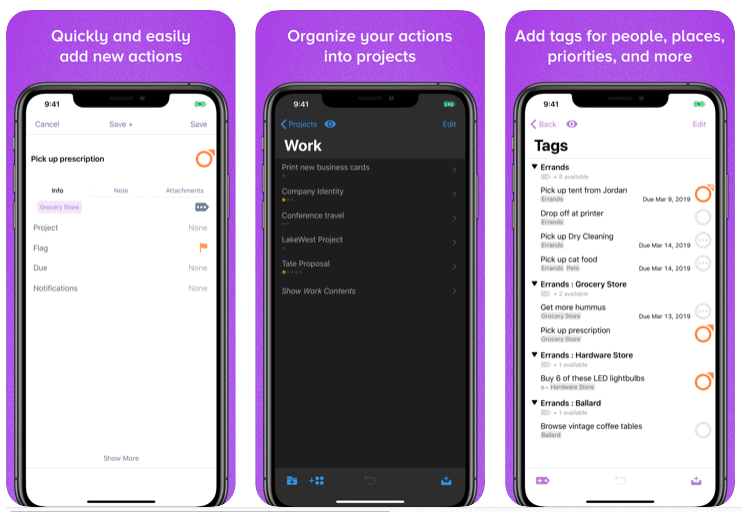 OmniFocus 2, for iOS users, is the best to-do list app and worth the price tag as it comprehensively organizes all your tasks. Color-coded labels make it easy for you to add and identify the task and get it into your inbox. The ability to add tasks in different folders or lists makes managing your tasks even more efficient in OmniFocus 2. The complexity of this app’s interface may be challenging to some users. But it’s this app the perfect choice for all you power users out there. Cost - Basic - $39.99 | Pro - $79.99 Available on iOS
OmniFocus 2, for iOS users, is the best to-do list app and worth the price tag as it comprehensively organizes all your tasks. Color-coded labels make it easy for you to add and identify the task and get it into your inbox. The ability to add tasks in different folders or lists makes managing your tasks even more efficient in OmniFocus 2. The complexity of this app’s interface may be challenging to some users. But it’s this app the perfect choice for all you power users out there. Cost - Basic - $39.99 | Pro - $79.99 Available on iOS
10. Things 3
 Things 3 is another basic to-do list app which aims at solving all your task scheduling worries. It is one of the most simple and attractive apps on the list. It is a decent option for iOS users when it comes to task scheduling as it offers Google Chrome extension and keeps you updated in the browser while working. However, according to The Verge review, this simplicity can be a big turn off for many. According to reviewers, Things 3 also lacks intuitiveness and is not worth its price tag. Cost - $9.99 Available on iOS | Chrome
Things 3 is another basic to-do list app which aims at solving all your task scheduling worries. It is one of the most simple and attractive apps on the list. It is a decent option for iOS users when it comes to task scheduling as it offers Google Chrome extension and keeps you updated in the browser while working. However, according to The Verge review, this simplicity can be a big turn off for many. According to reviewers, Things 3 also lacks intuitiveness and is not worth its price tag. Cost - $9.99 Available on iOS | Chrome
11. TickTick
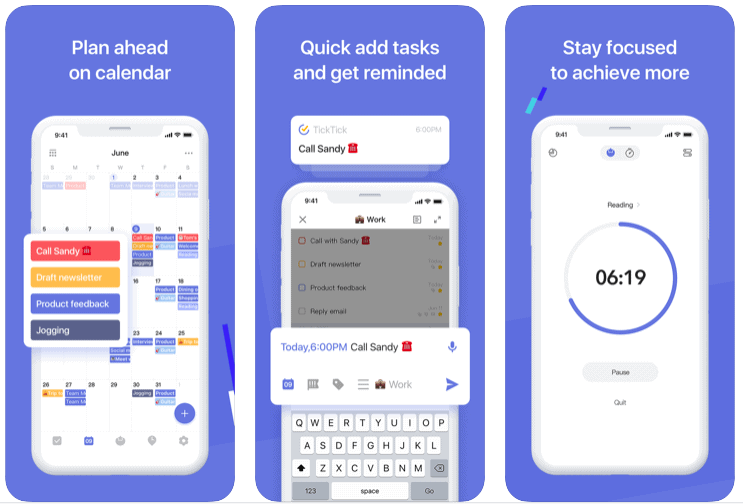 TickTick allows you to add tasks, subtasks, custom reminders, deadlines, as well as recurring tasks for a day, a week, or a month. In order to provide you more ease in task scheduling, TickTick, in its pro version, offers a nice calendar view, where you can add or edit tasks on a weekly or daily basis. It also has experimental features, which you can turn on if you want to try out beta capabilities. Along with iOS and Android apps, TickTick does offer Windows as well as Mac apps for better assistance in task management. Cost - $2.79 per month Available on Web | Android | iOS | Chrome
TickTick allows you to add tasks, subtasks, custom reminders, deadlines, as well as recurring tasks for a day, a week, or a month. In order to provide you more ease in task scheduling, TickTick, in its pro version, offers a nice calendar view, where you can add or edit tasks on a weekly or daily basis. It also has experimental features, which you can turn on if you want to try out beta capabilities. Along with iOS and Android apps, TickTick does offer Windows as well as Mac apps for better assistance in task management. Cost - $2.79 per month Available on Web | Android | iOS | Chrome
12. Ayoa
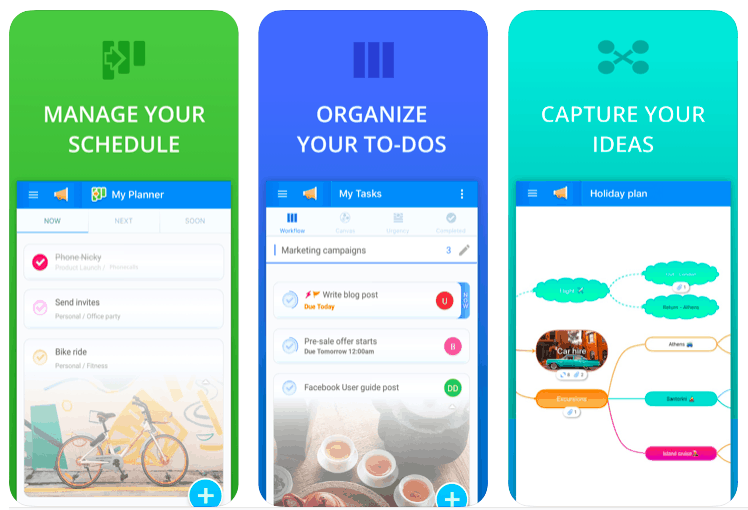 Ayoa, another team and task management app, provides world-class assistance in coordinating all your projects. Ayoa, a versatile task management app, also offers the best visual coordination with color-based linked circles. Cost - Free Available on Web | Android | iOS | Windows
Ayoa, another team and task management app, provides world-class assistance in coordinating all your projects. Ayoa, a versatile task management app, also offers the best visual coordination with color-based linked circles. Cost - Free Available on Web | Android | iOS | Windows
13. Remember The Milk
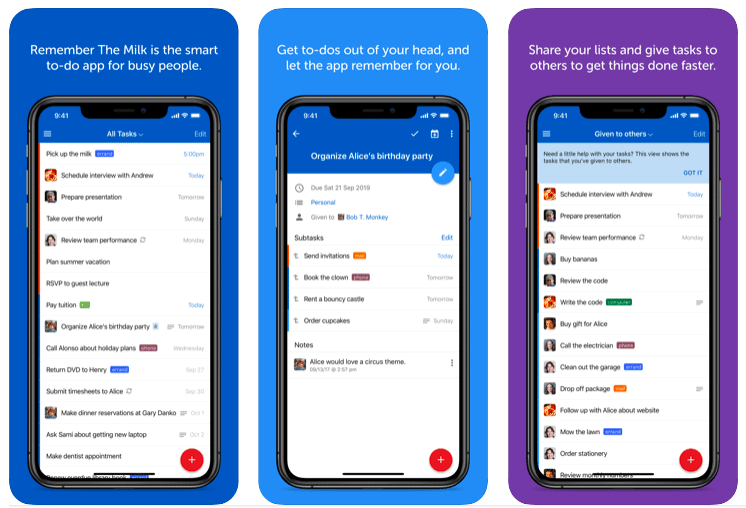 One of the oldest to-do list apps, Remember The Milk, is a simple tool to add, organize and finish the tasks in the easiest way possible. Remember The Milk’s smart listings help you to identify all the tasks that have due dates for the week. Along with automated task prioritization, simple, intuitive and easy UI is one of the best features of the app. Integration with Google Calendar, Outlook, and Gmail allows you to see and update all your tasks in the app and offers omnichannel assistance. Cost - Free | $39.99 per year Available on Web | Android | iOS | Chrome
One of the oldest to-do list apps, Remember The Milk, is a simple tool to add, organize and finish the tasks in the easiest way possible. Remember The Milk’s smart listings help you to identify all the tasks that have due dates for the week. Along with automated task prioritization, simple, intuitive and easy UI is one of the best features of the app. Integration with Google Calendar, Outlook, and Gmail allows you to see and update all your tasks in the app and offers omnichannel assistance. Cost - Free | $39.99 per year Available on Web | Android | iOS | Chrome
14. TeuxDeux
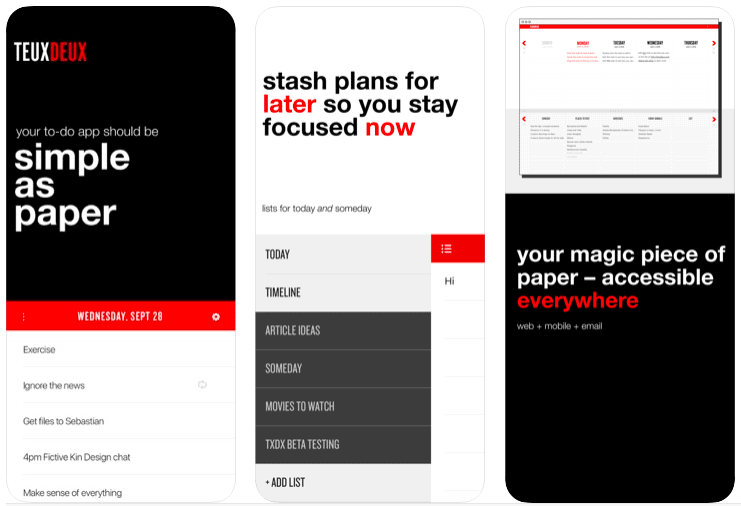 Almost all to-do apps let you schedule your tasks for the day. But how about organizing all the tasks for a week? That’s where TeuxDeux differs from others. This useful app lets you schedule and organizes all your tasks for the whole week. Just add the tasks below the day column and you are done. Want to move a task from one column to another? No worries. Its drag-and-drop interface lets you rearrange the task and add it to different day’s column. Additionally, TeuxDeux lets you add repeating tasks for a day. Cost - $3 per month Available on Web | iOS
Almost all to-do apps let you schedule your tasks for the day. But how about organizing all the tasks for a week? That’s where TeuxDeux differs from others. This useful app lets you schedule and organizes all your tasks for the whole week. Just add the tasks below the day column and you are done. Want to move a task from one column to another? No worries. Its drag-and-drop interface lets you rearrange the task and add it to different day’s column. Additionally, TeuxDeux lets you add repeating tasks for a day. Cost - $3 per month Available on Web | iOS
15. Focuster
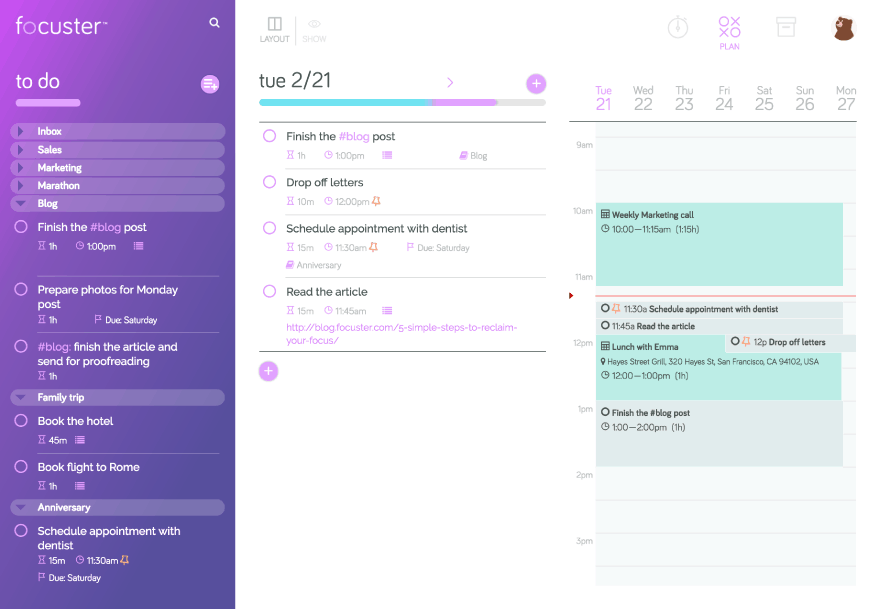 Focuster is an automated task scheduling application, which makes it the first of its kind. With Focuster, you just need to add all your tasks in the left sidebar and the tool automatically will arrange them according to their priority. After adding all the tasks, just press the Now button and the tool will show the tasks you should be focusing on for the day. Apart from offering automated task listing, Focuster comes with numerous integrations, which makes it one of the most powerful to-do list apps. Cost - Starts from $9.99/month Available on Web | Chrome
Focuster is an automated task scheduling application, which makes it the first of its kind. With Focuster, you just need to add all your tasks in the left sidebar and the tool automatically will arrange them according to their priority. After adding all the tasks, just press the Now button and the tool will show the tasks you should be focusing on for the day. Apart from offering automated task listing, Focuster comes with numerous integrations, which makes it one of the most powerful to-do list apps. Cost - Starts from $9.99/month Available on Web | Chrome
16. Momentum
 Momentum is a browser-based start page and to-do list app, which is available as an extension on popular web browsers such as Google Chrome and Mozilla Firefox. It offers a new wallpaper every day when you open a browser with amazing features such as to-do listing, Bing and Google search, weather reports, time and unique inspirational quote. Momentum offers to-do listing and syncing between devices in its free plan, although most of its useful features are available in its premium version. These features include autofocus, notes, work hours, reminders, and many more. Momentum is best for users who spend most of their time browsing the internet and need assistance on quickly adding tasks and taking notes. Cost - Free | $2.50 per month Available on Chrome | Firefox
Momentum is a browser-based start page and to-do list app, which is available as an extension on popular web browsers such as Google Chrome and Mozilla Firefox. It offers a new wallpaper every day when you open a browser with amazing features such as to-do listing, Bing and Google search, weather reports, time and unique inspirational quote. Momentum offers to-do listing and syncing between devices in its free plan, although most of its useful features are available in its premium version. These features include autofocus, notes, work hours, reminders, and many more. Momentum is best for users who spend most of their time browsing the internet and need assistance on quickly adding tasks and taking notes. Cost - Free | $2.50 per month Available on Chrome | Firefox
17. Asana
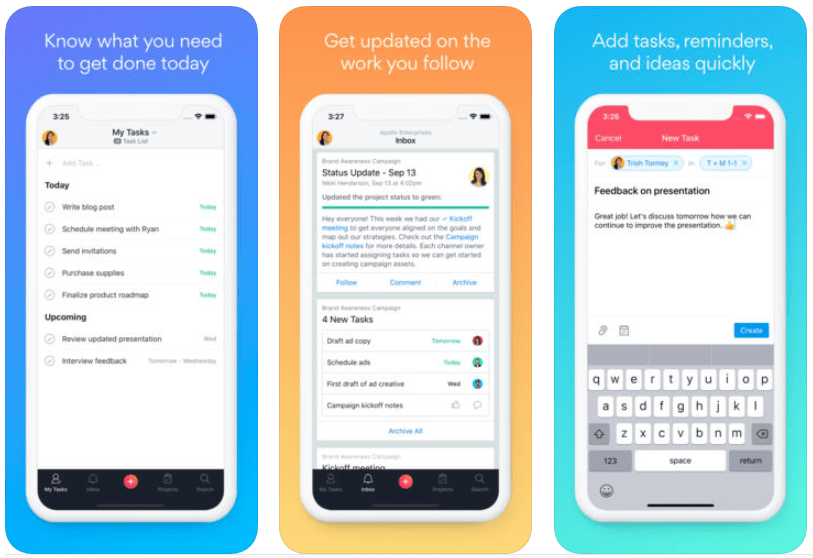 Asana is a business-oriented to-do list app. It is best suited for larger teams who collaborate often. It offers some of the best features available, such as task categories, tagging options, and deep sorting, in addition to numerous ways to add extra information to a task. One of the features I like most about this app is that it offers a separate thread for each task, which solves all of your communication worries. You can share or discuss a task with only those involved, without disturbing others. Asana does offer a decent number of features in its free plan but the pro version is way more useful and best fit for a large-sized team. Cost - Free | $9.99 per user per month Available on Web | Android | iOS
Asana is a business-oriented to-do list app. It is best suited for larger teams who collaborate often. It offers some of the best features available, such as task categories, tagging options, and deep sorting, in addition to numerous ways to add extra information to a task. One of the features I like most about this app is that it offers a separate thread for each task, which solves all of your communication worries. You can share or discuss a task with only those involved, without disturbing others. Asana does offer a decent number of features in its free plan but the pro version is way more useful and best fit for a large-sized team. Cost - Free | $9.99 per user per month Available on Web | Android | iOS
18. Basecamp
 Basecamp is one of the most popular applications for task management. In its fully-enabled project management tool, Basecamp offers business-oriented features such as milestone management, file sharing, time tracking, and forum-like messaging. Basecamp’s to-do list feature works much like Asana, which offers separate threads for each task. You can assign the task to team members with due dates and add details for the task in the form of comments. Even though Basecamp is a fully premium app, you can use its 30-day free trial by signing up through with your email address. Cost - Starts from $99/ month Available on Web | Android | iOS
Basecamp is one of the most popular applications for task management. In its fully-enabled project management tool, Basecamp offers business-oriented features such as milestone management, file sharing, time tracking, and forum-like messaging. Basecamp’s to-do list feature works much like Asana, which offers separate threads for each task. You can assign the task to team members with due dates and add details for the task in the form of comments. Even though Basecamp is a fully premium app, you can use its 30-day free trial by signing up through with your email address. Cost - Starts from $99/ month Available on Web | Android | iOS
19. Trello
 Trello, a popular to-do list app and task management tool, offers features like drag-and-drop functionality and color-coded labeling. It also lets you organize your tasks in the most efficient way possible. It follows its own “boards” and “cards” structure, which allows you to segregate all your projects (boards) and then add tasks and subtasks (cards) into it. In cards, it offers the ability to add notes, checklists as well as deadlines. A nice and shiny calendar view of the app shows you all your tasks for the day, which is just amazing. Trello’s integration with popular applications such as Dropbox, Box, and Google Drive makes it the first choice for large businesses. Cost - Free | Business class $9.99 per user per month | Enterprise $20.83 per user per year Available on Web | Android | iOS | Windows
Trello, a popular to-do list app and task management tool, offers features like drag-and-drop functionality and color-coded labeling. It also lets you organize your tasks in the most efficient way possible. It follows its own “boards” and “cards” structure, which allows you to segregate all your projects (boards) and then add tasks and subtasks (cards) into it. In cards, it offers the ability to add notes, checklists as well as deadlines. A nice and shiny calendar view of the app shows you all your tasks for the day, which is just amazing. Trello’s integration with popular applications such as Dropbox, Box, and Google Drive makes it the first choice for large businesses. Cost - Free | Business class $9.99 per user per month | Enterprise $20.83 per user per year Available on Web | Android | iOS | Windows
The Bottom Line
Using a to-do list app is one of the easiest methods of task management. They offer complete control over adding, organizing, and finishing tasks in a jiffy. Additionally, to-do list apps ensure that task recording is being done properly and they monitor the progress of the project as well as your team. However, you need to do your research to find the best to-do list app or task management platform for you depending upon your requirements. Choose the best to-do list app for you from the list to make task management easy and simple. All these apps also let your teamwork with tightly aligned coordination, which helps improve productivity.More Productivity Apps for Better Time Management
- 18 Best Time Management Apps and Tools
- 15 Organization Apps to Boost Your Personal Productivity
- 40 Top Productivity Apps for iPhone
from Lifehack - Feed https://ift.tt/2PqGZWo